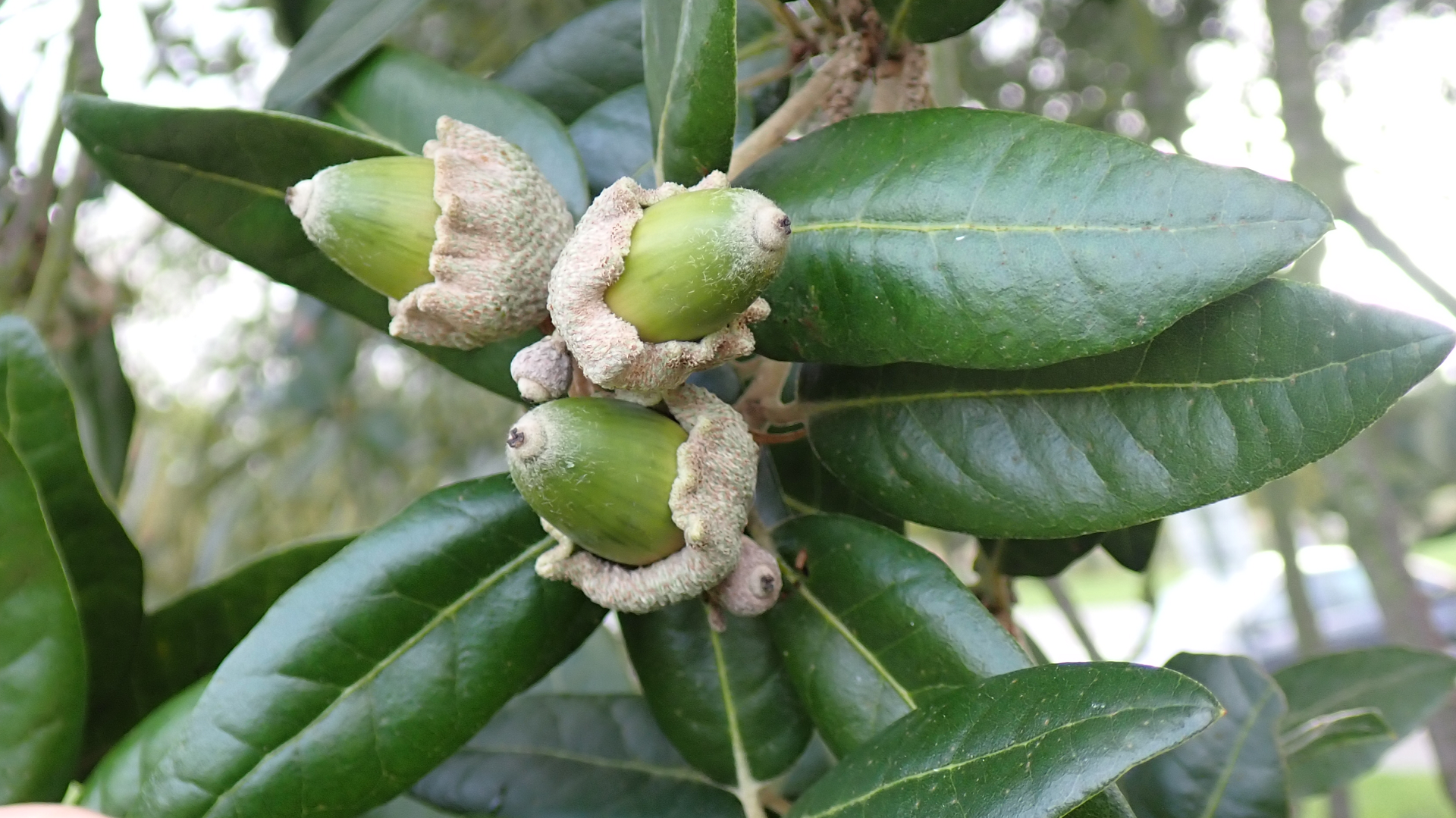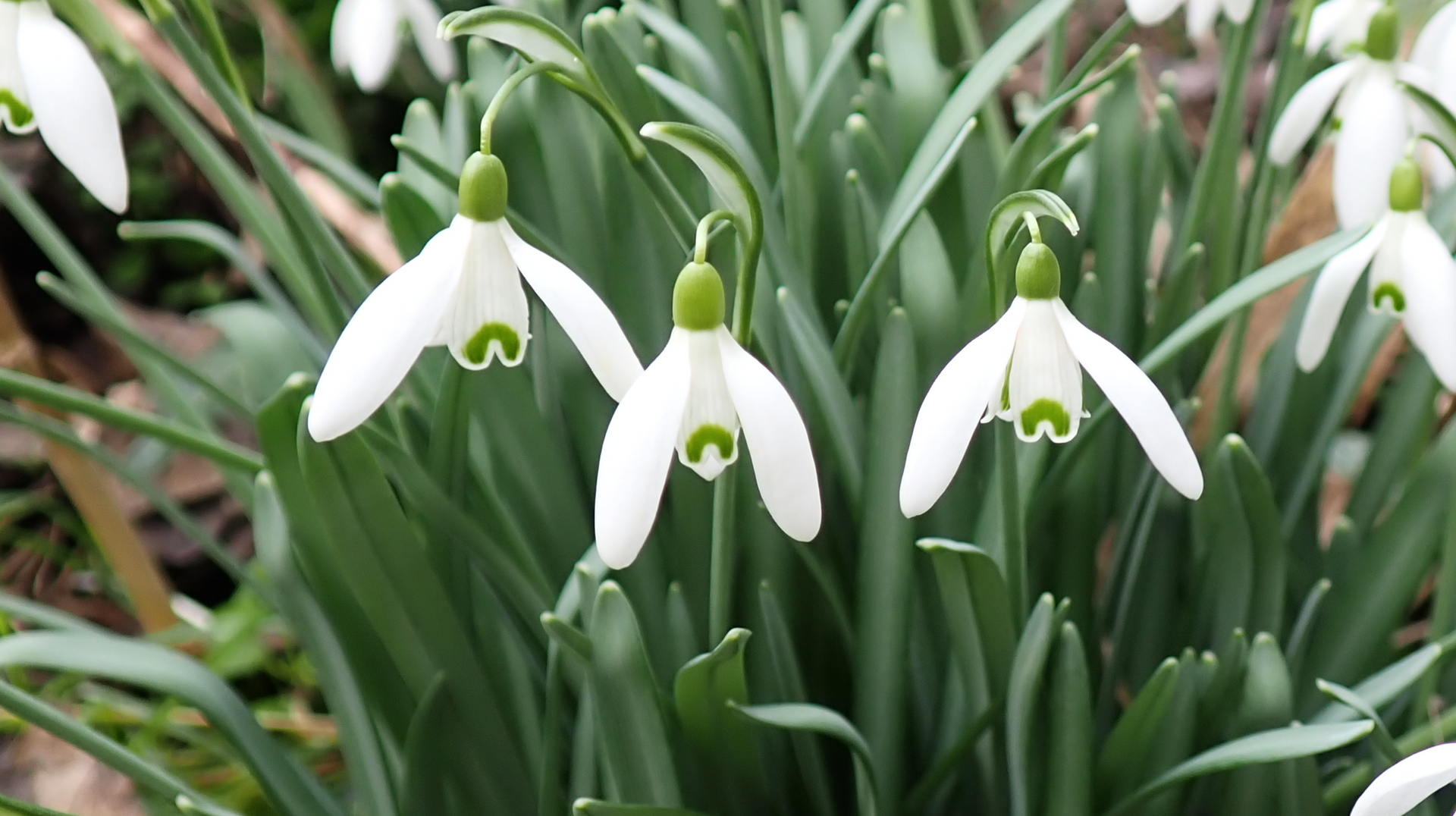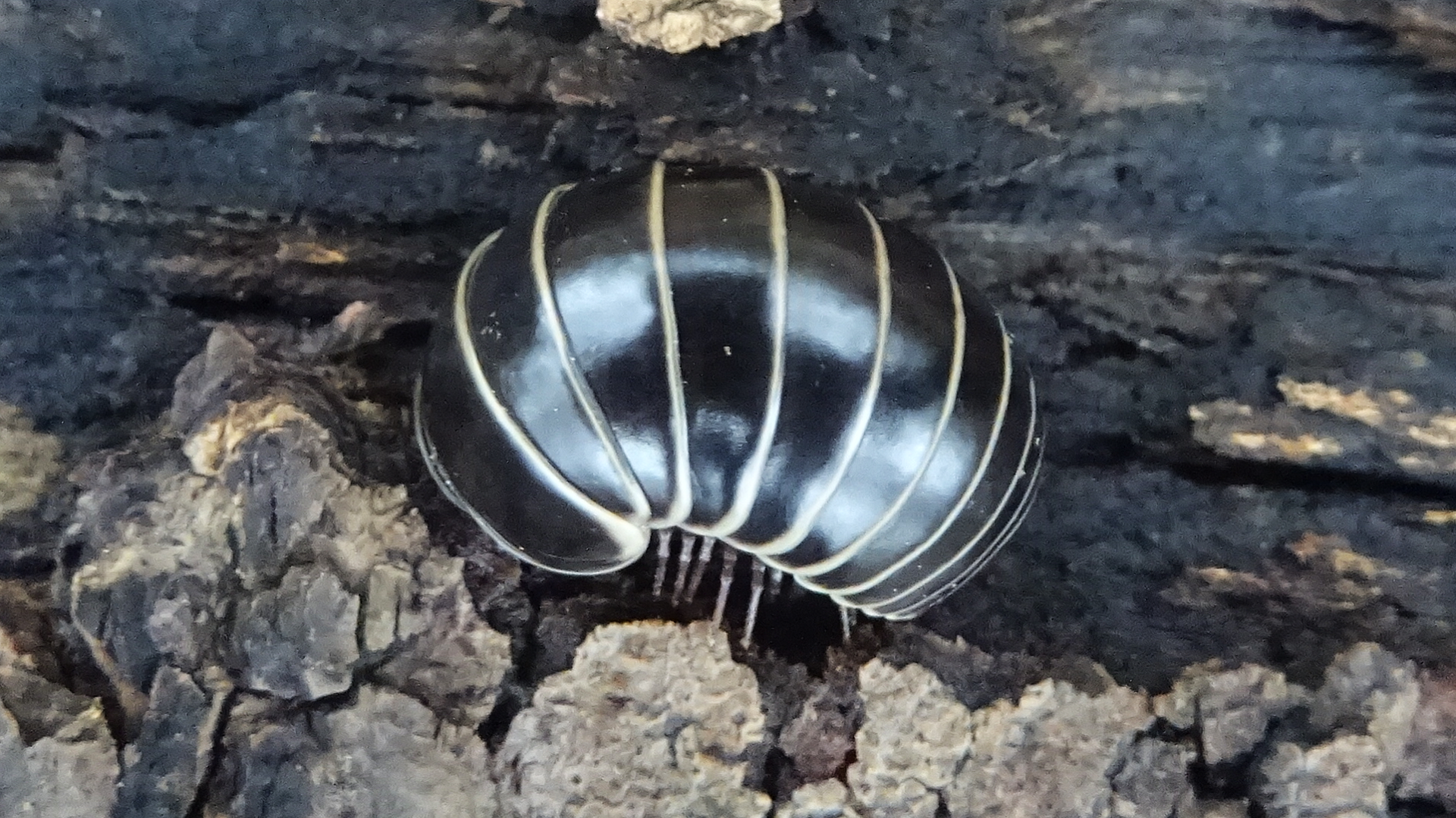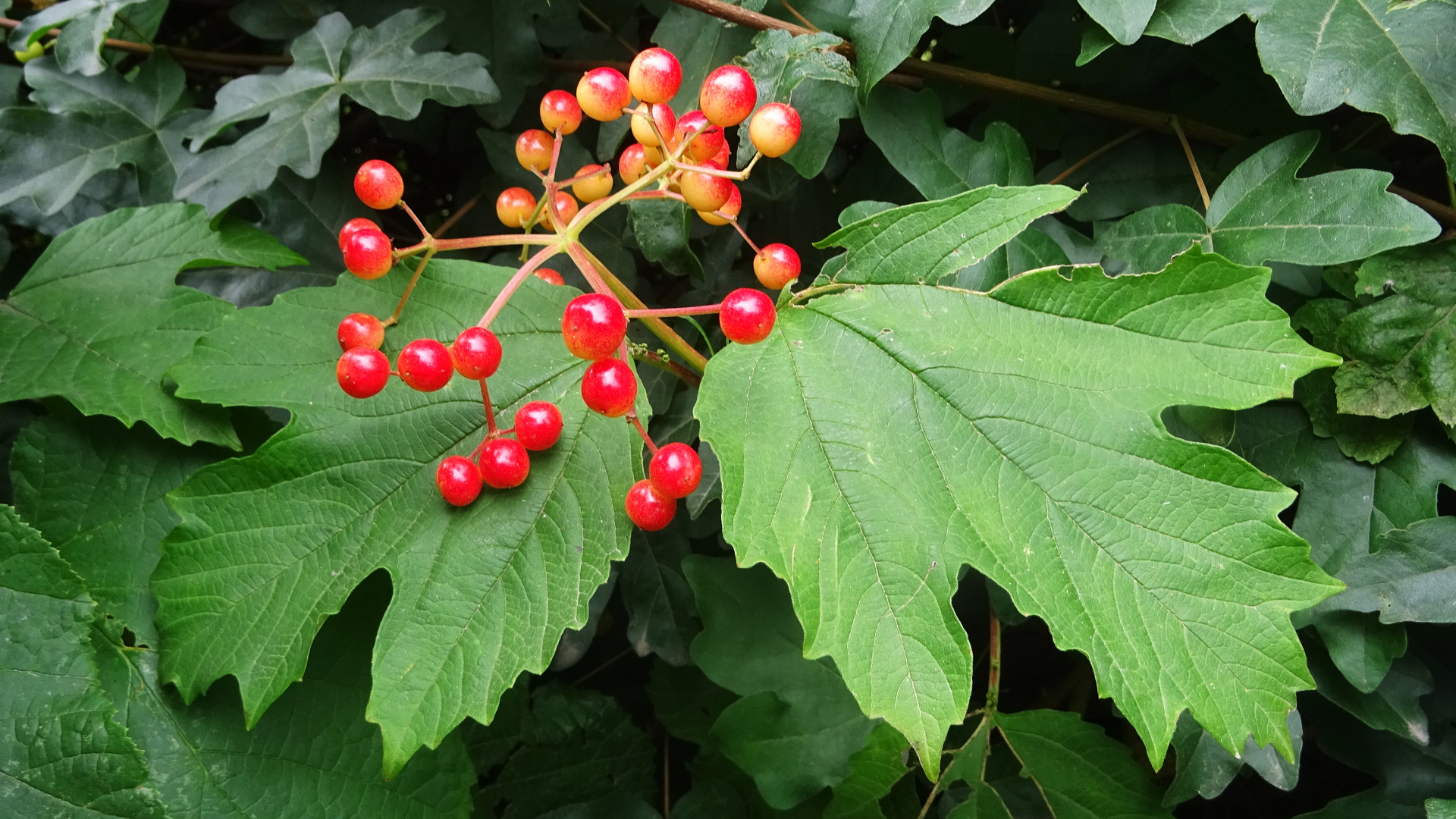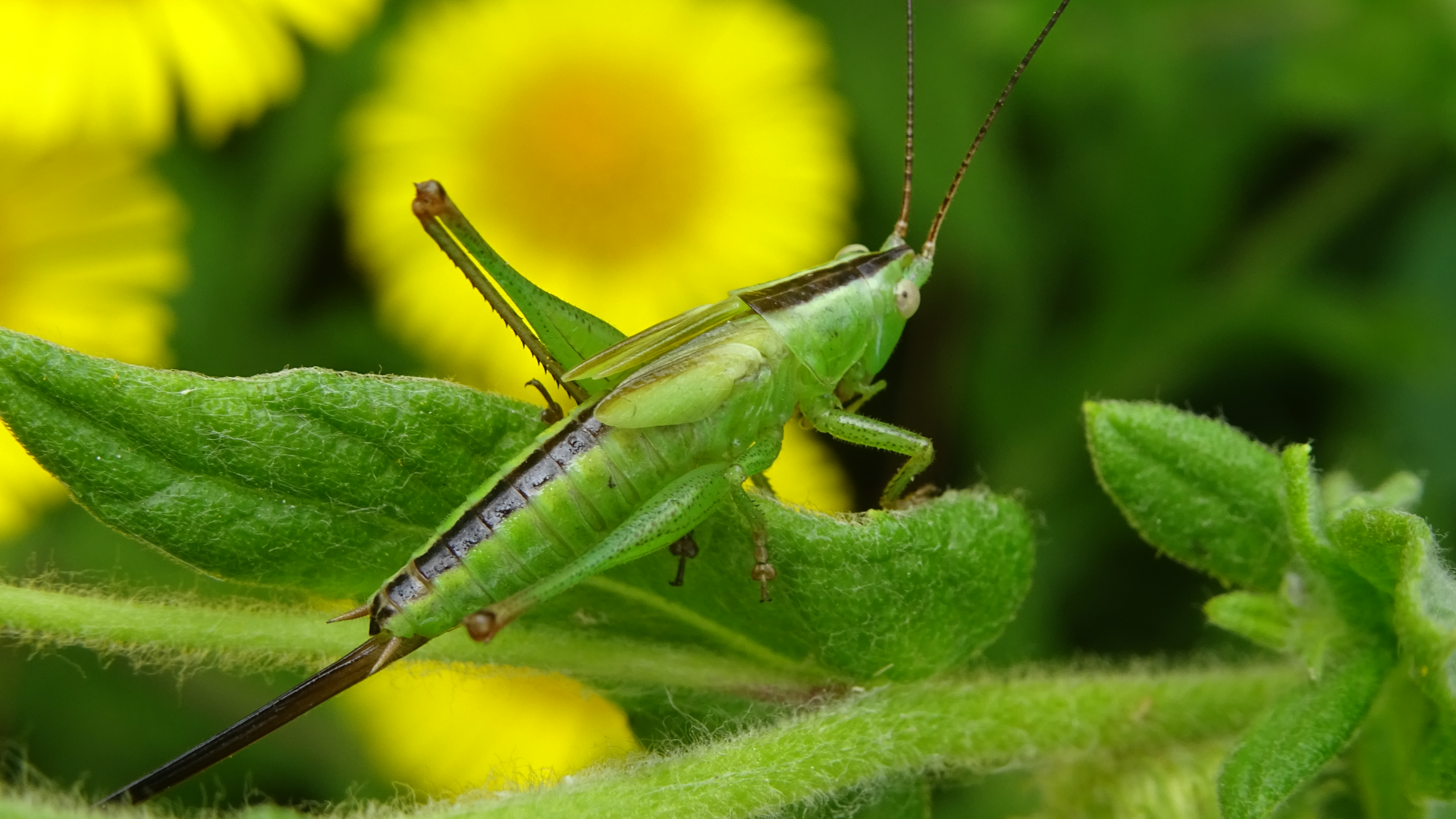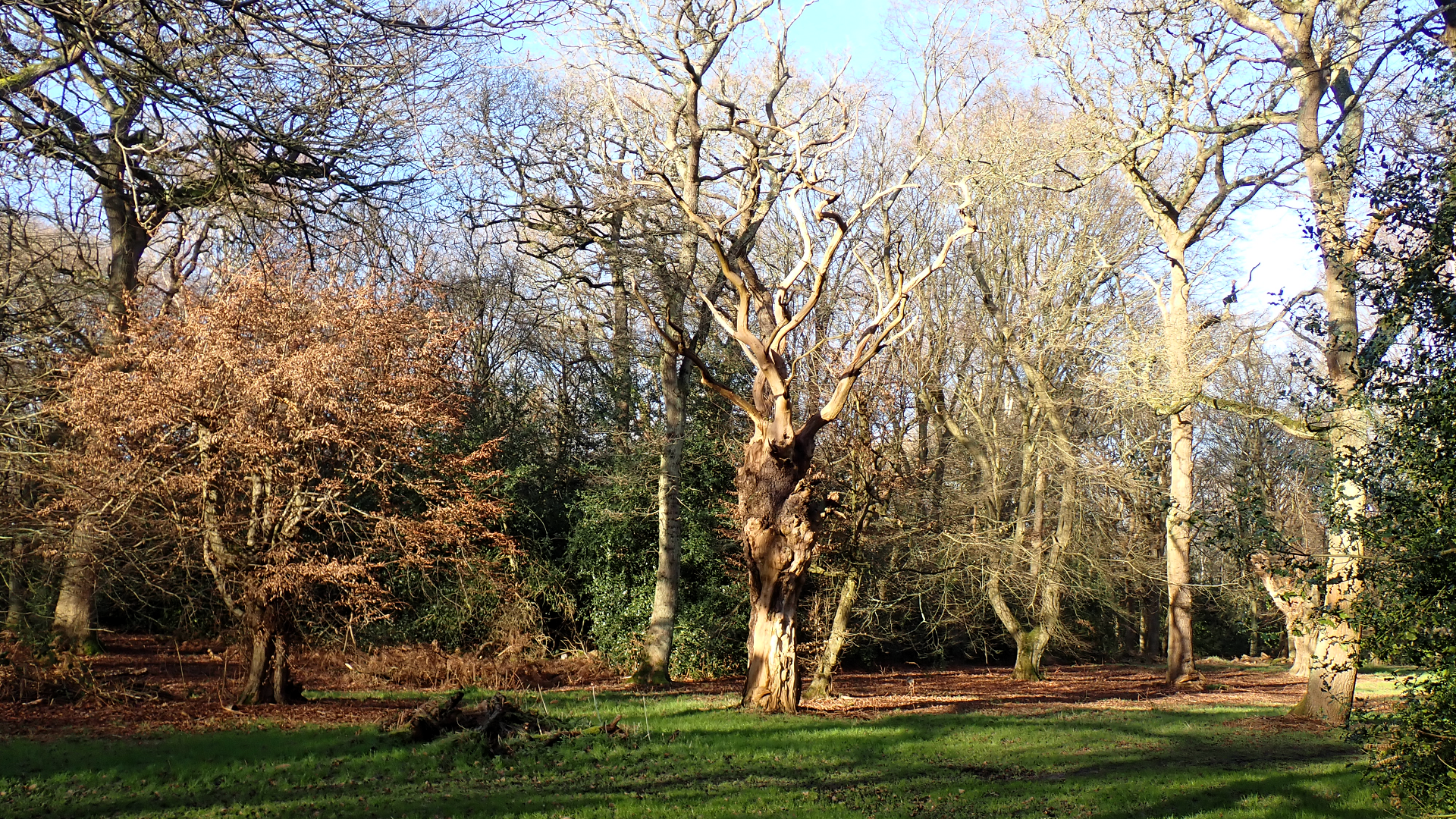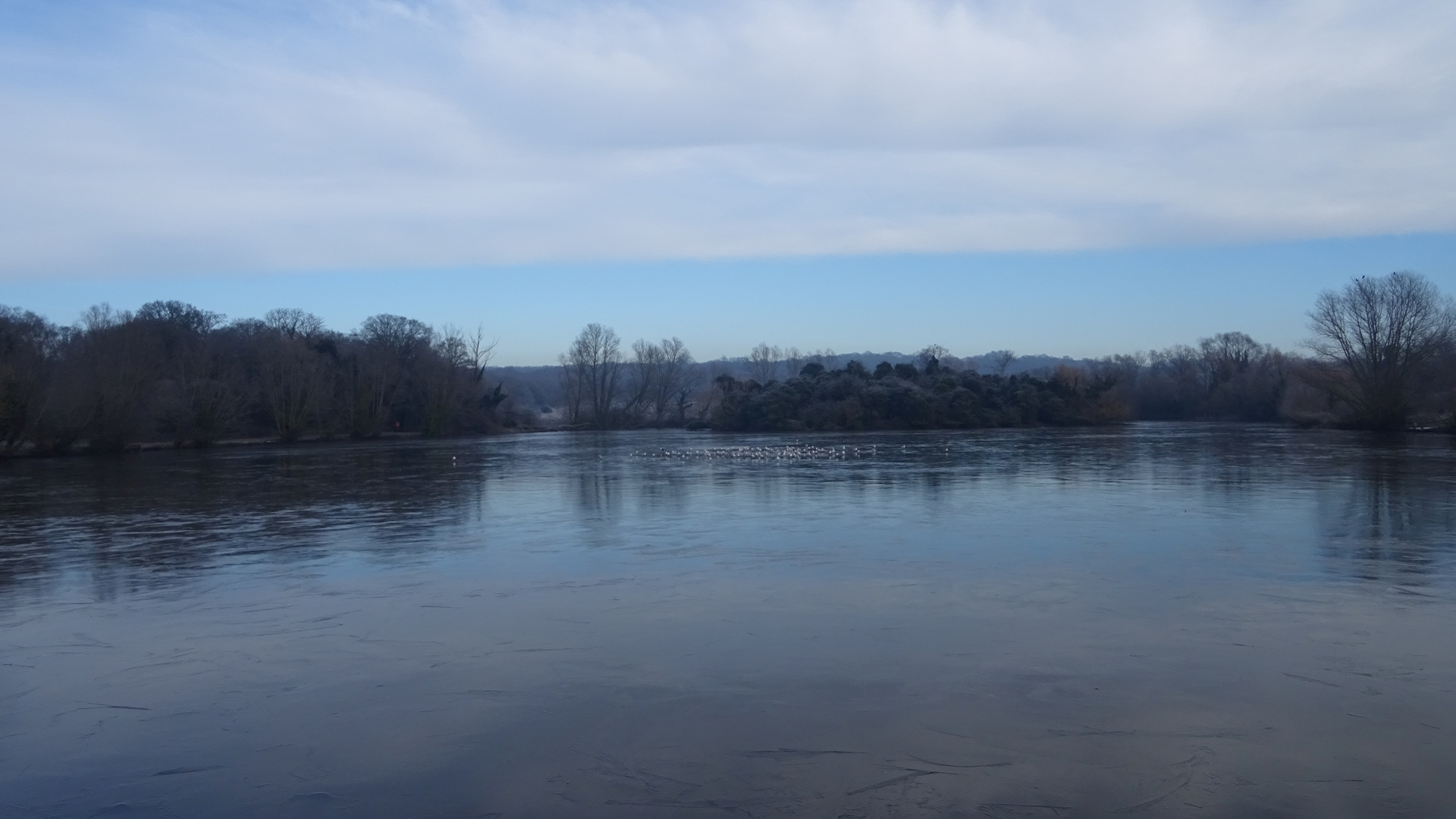© Raymond Small TQ4792 03/11/2023
Acorns on Holm Oak
Quercus ilex
near the second car park. One to three acorns, 12-18mm long, are normally found growing on short downy stalks. They have pointed tips and the irregular-shaped cups have scales. Young acorns are green maturing to reddish-brown before dropping off the tree. Holm Oak is an evergreen.
© Raymond Small TQ4792 15/02/2024
Snowdrops are among the earliest spring bulbs to bloom. They were not recorded in Britain until the late 18th century, but have now naturalised. Any found in this country are probably descended from bulbs introduced from the continent.
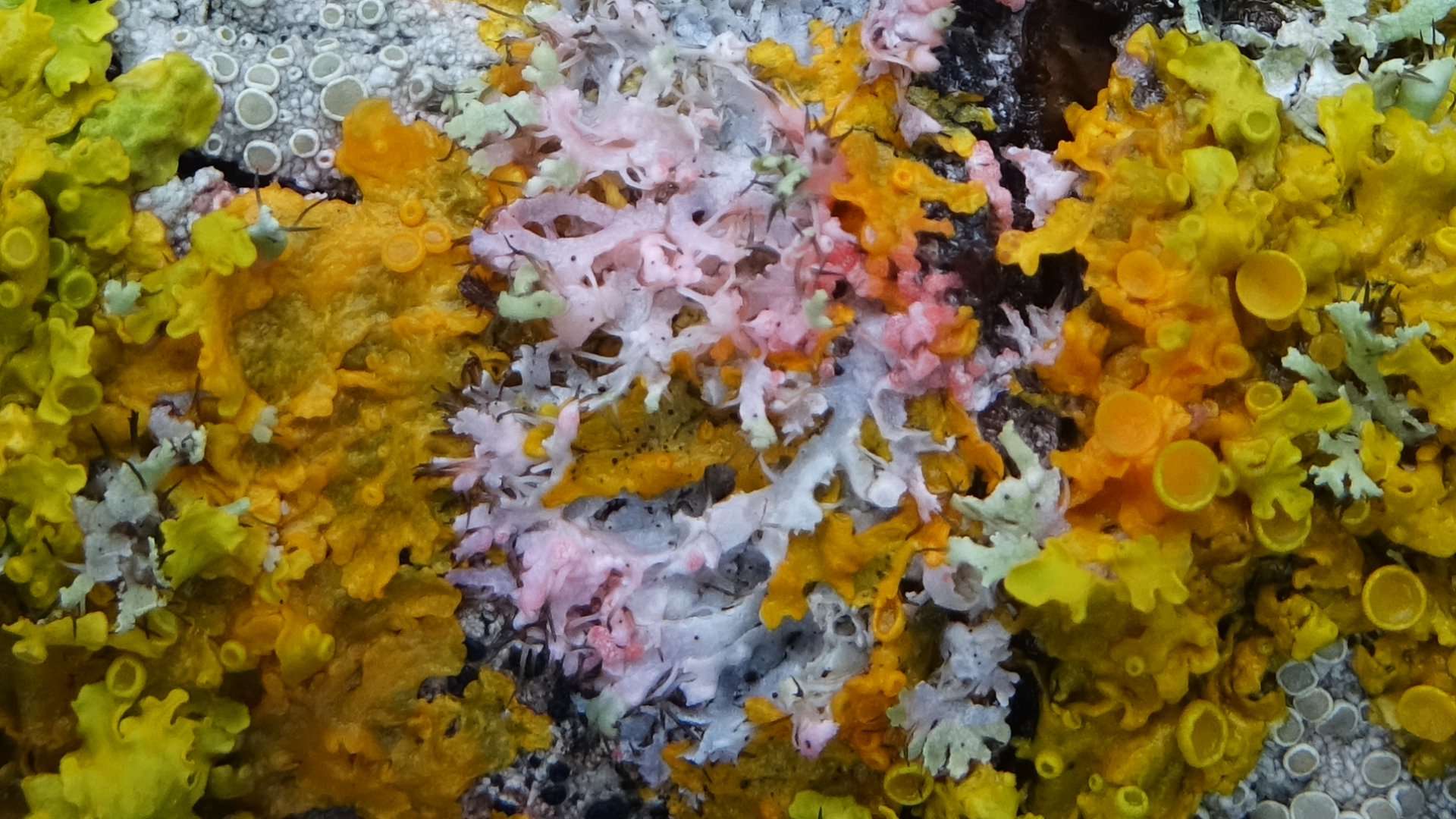
© Raymond Small TQ4792 05/01/2024
The lichenicolous fungus Laetisaria lichenicola is associated with attacking the thallus of lichen Physcia tenella. During January 2016, Brian Ecott made a chance discovery of the pink fungus and searched books and the internet for an answer and eventually found a paper published in America showing a pink portion of lichen. Armed with this information, he contacted Essex Field Club Lichenologist, John Skinner and the London Natural History Society. Dry specimens were sent to specialist Lichenologist, Mark Powell, who examined the specimen under the microscope to compare the details with that of Paul Diederich et al 2011 paper. Details were then forwarded to Dr. Brian Coppins, at the Royal Botanic Gardens, Edinburgh. Brian's discovery was confirmed as the first record in the United Kingdom, thus "Putting Hainault on the Map". During Winter 2024 the pink fungus seemed well-established on trees near Foxburrow Pond.
© Raymond Small TQ4793 24/12/2023
Pill Millipedes
Glomeris marginata are mainly active at night when they feed on dead organic debris. During the day they often hide under logs and stones. This species is normally shiny black with each tergite having a pale margin. When sensing danger they curl up, but do not form a complete ball. Each segment has two pairs of legs per segment. Females are 8-20mm long and males 7-15mm long.
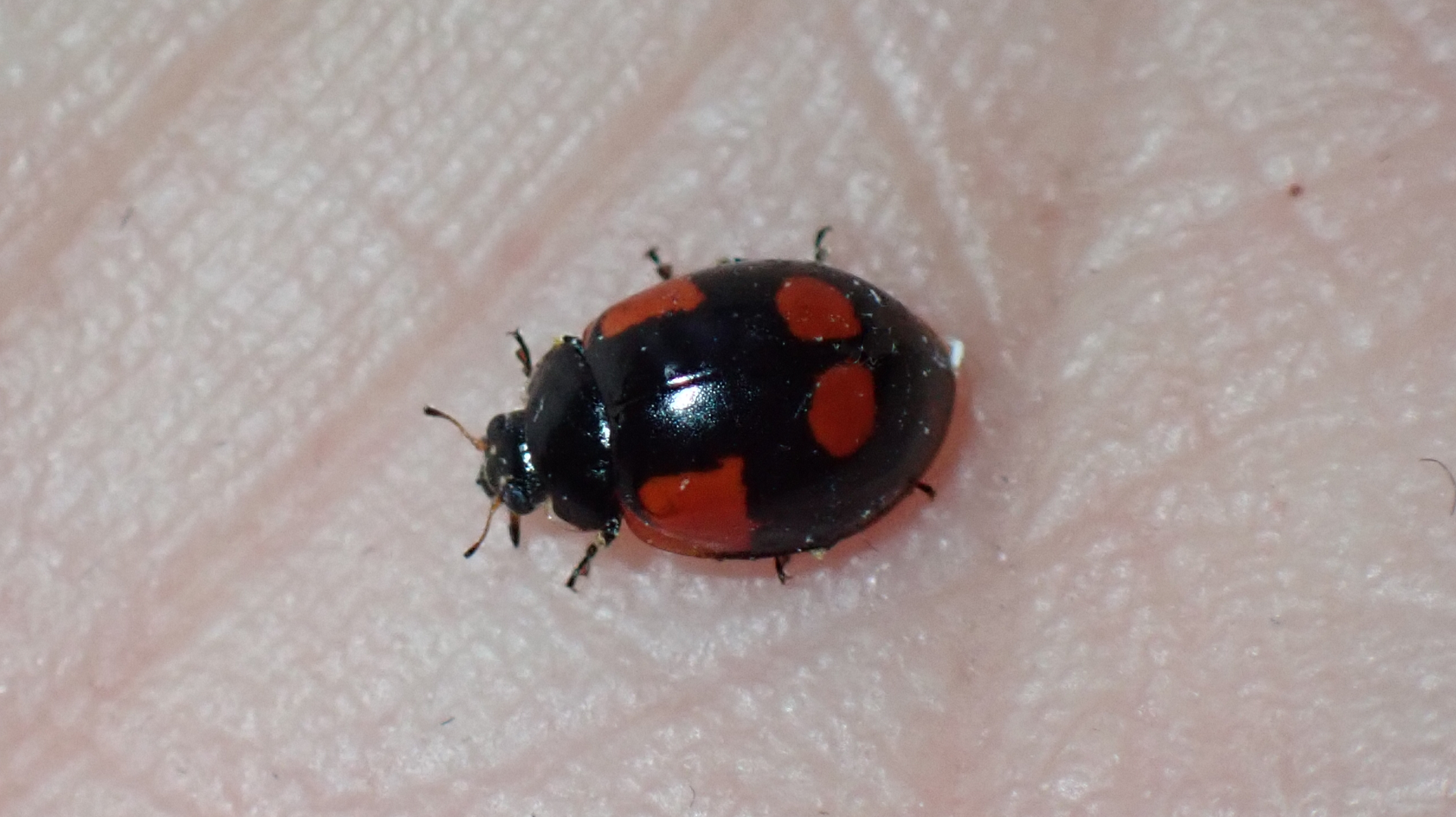
© Raymond Small TQ4792 29/01/2024
Two-spot Ladybirds Adalia bipunctata are voracious hunters found in a range of habitats where aphids on which they feed exist. These small ladybirds can be either red with black spots or black with red spots - sometimes with multiple spots. They hibernate during winter and usually become active during late February or March. This picture shows form quadrimaculata.
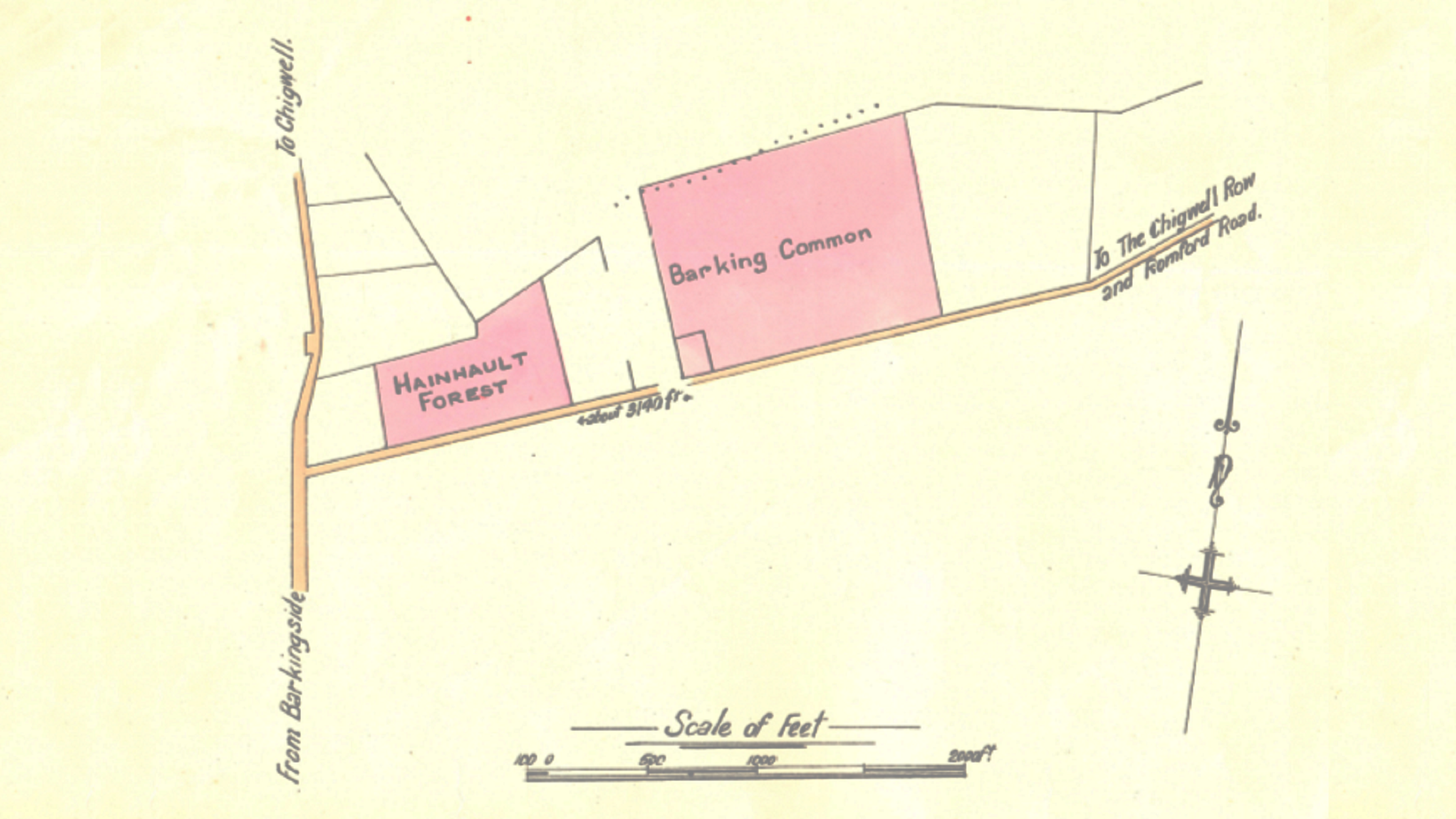
This deed map shows the site of Maypole Crescent and the area where Kelvin Hughes stood as 'Hainhault forest' and a chunk of Manford Way east of Limes avenue as Barking Common.
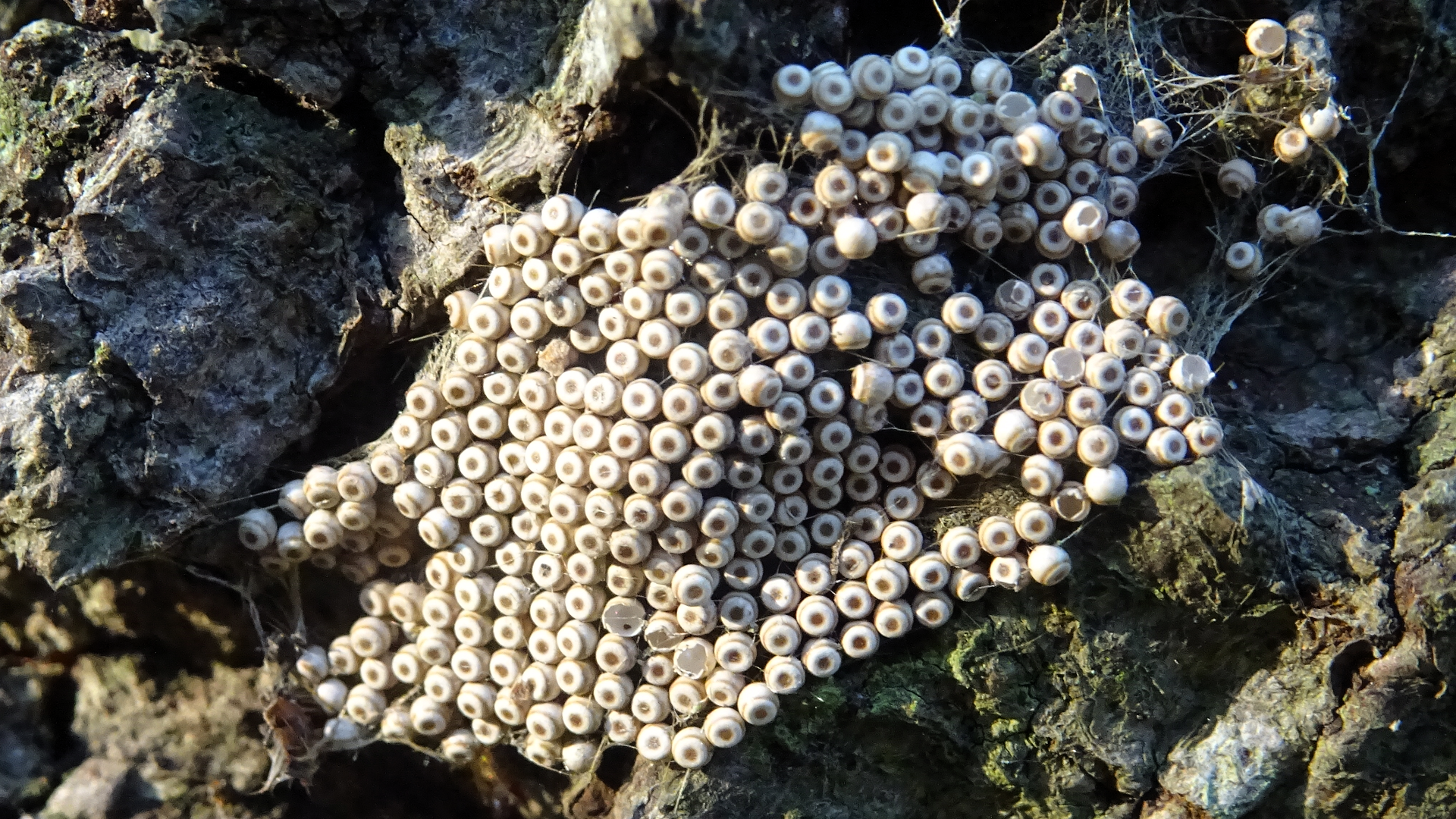
© Raymond Small TQ4792 16/01/2024
A batch of Vapourer Moth eggs on the trunk of an Oak tree. Strands of silk belonging to the female's cocoon from last year can be seen underneath. The female is flightless.
PEAFOWL
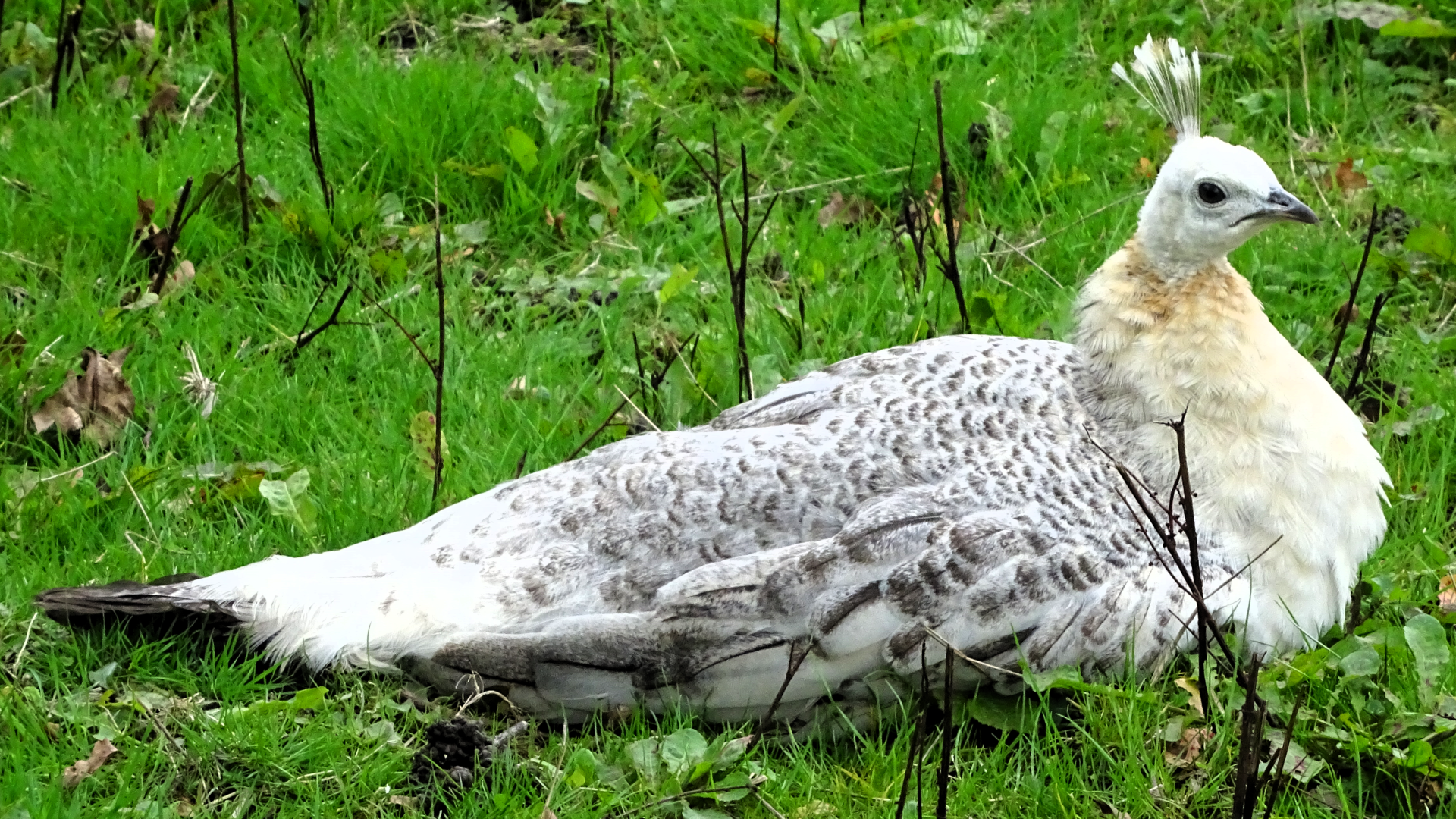
© Raymond Small TQ4792 06/10/2024
Female Peafowl are known as 'Peahens'. Females have drabber colours and shorter tails than the males known as 'Peacocks'. They also have a different call when communicating. Peafowl can be seen at Foxburrow Farm.
STONECHAT
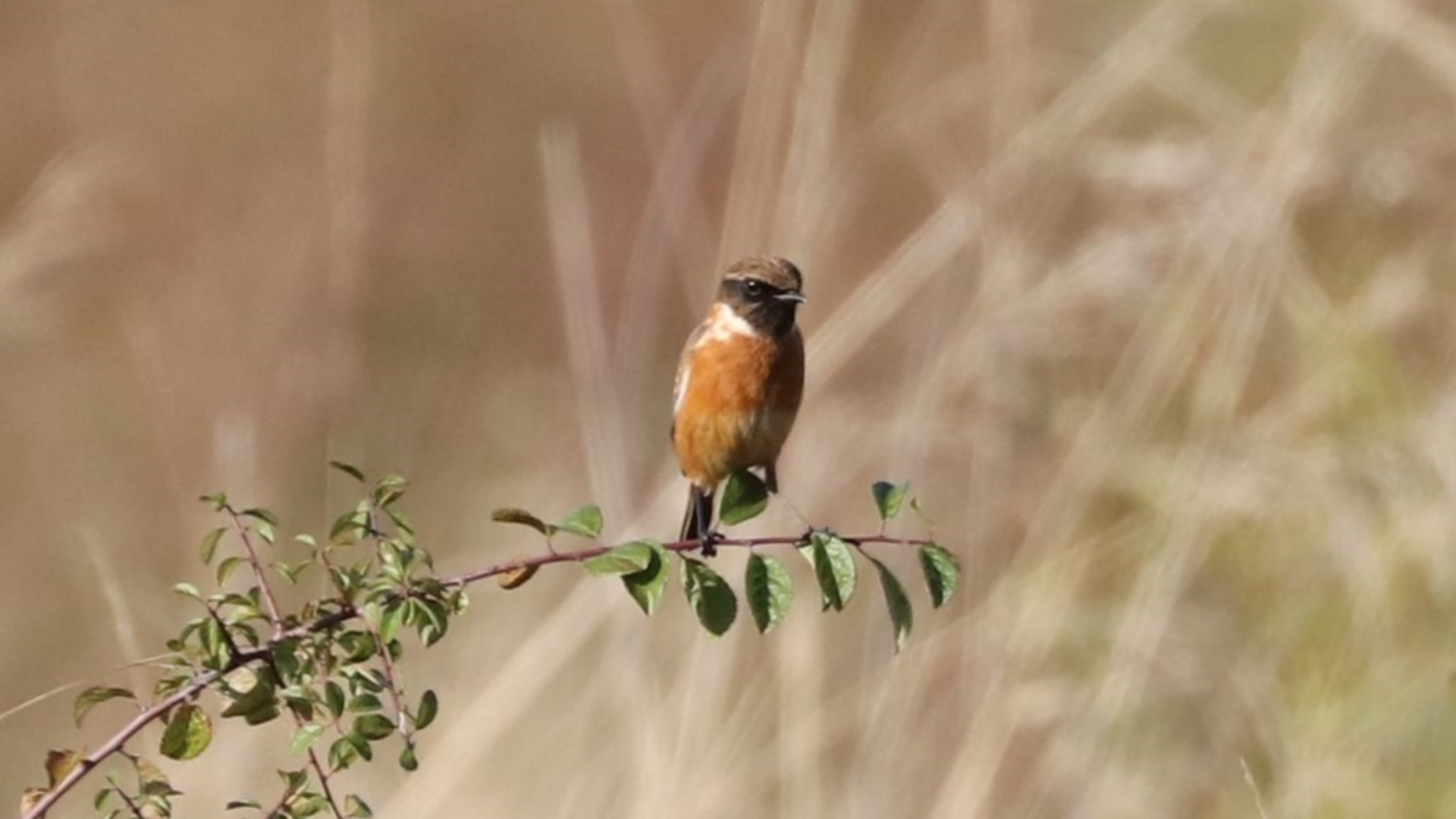
© Michael Trump TQ4793 15/10/2024
Saxicola rubicola
Stonechats are small birds about the size of a robin. They are usually winter visitors to Hainault Forest. This male was photographed on the scrub area on Millennium Hill.
ORB WEB
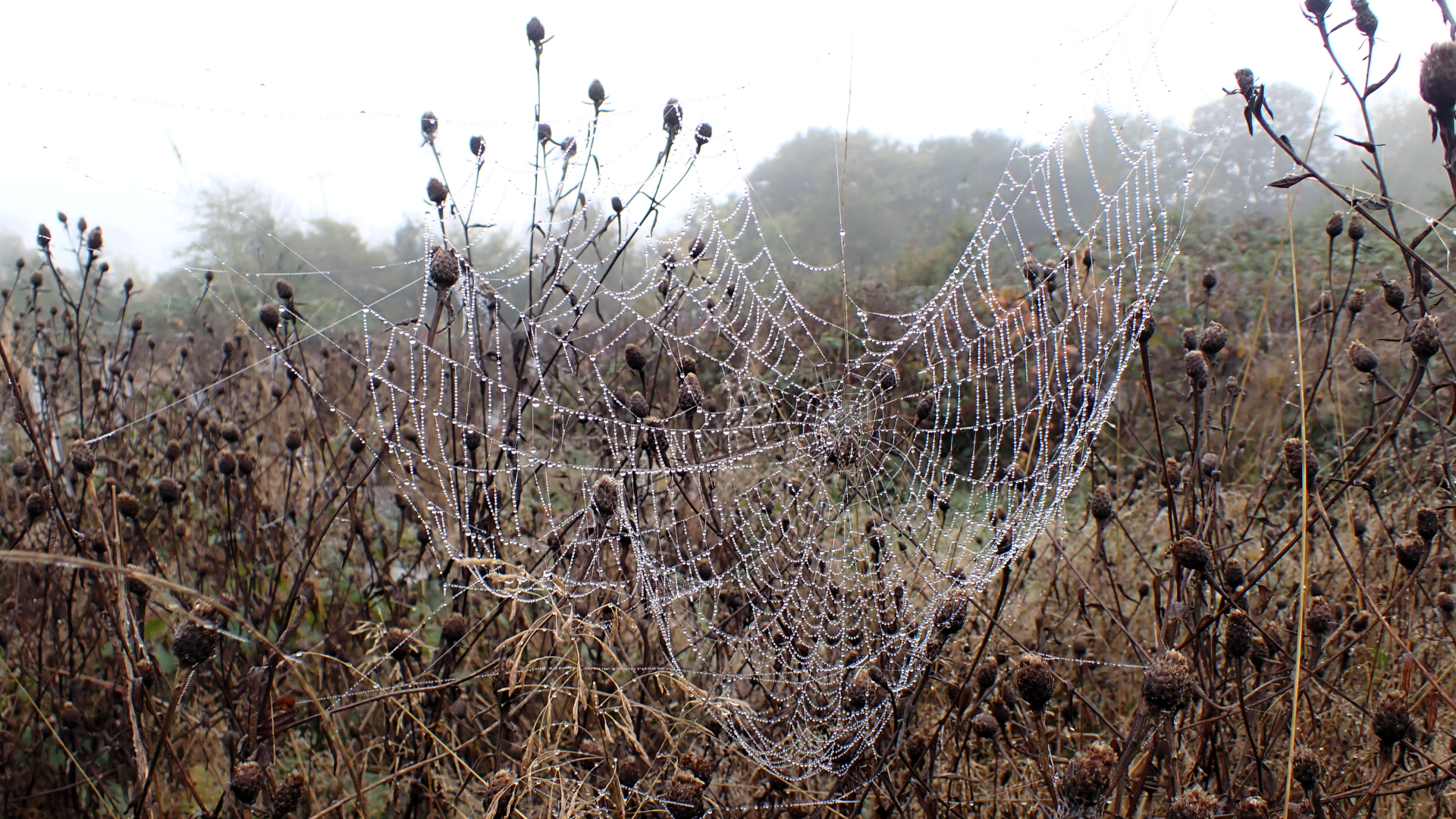
© Raymond Small TQ4792 18/10/2024
Webs are an efficient way for spiders to trap prey because it means they do not spend energy chasing a meal. However, spinning a web is not cost free and a huge amount of energy is spent making the silk. Over time the silk loses adhesiveness and becomes ineffective. Many spiders resort to eating their web daily to recycle the silk proteins enabling them to spin a fresh web.
HARLEQUIN LADYBIRD
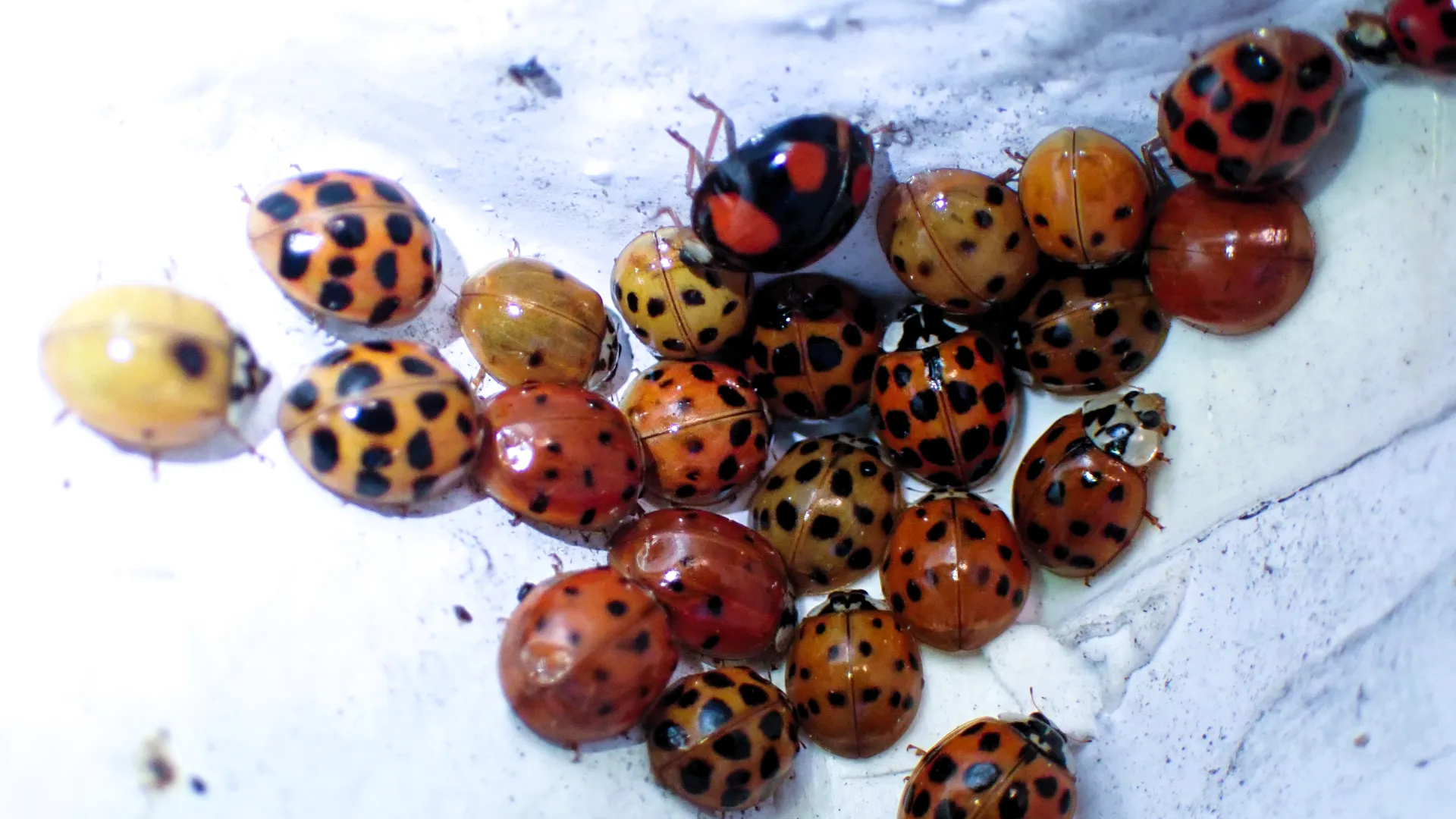
© Raymond Small TQ4792 16/10/2024
Harmonia axyridis
Vision's office at Foxburrow Barn had a Ladybird infestation. Sometimes they enter buildings through cracks in window frames or gaps around doors when seeking shelter. The Harlequin ladybird is an invasive species from Eastern Asia that established itself in Britain during 2004 and has now become widespread across south-east England. It is very variable in colour and markings, measuring 8-10mm in length. These pictures show variants sheltering in corners around the entrance door.
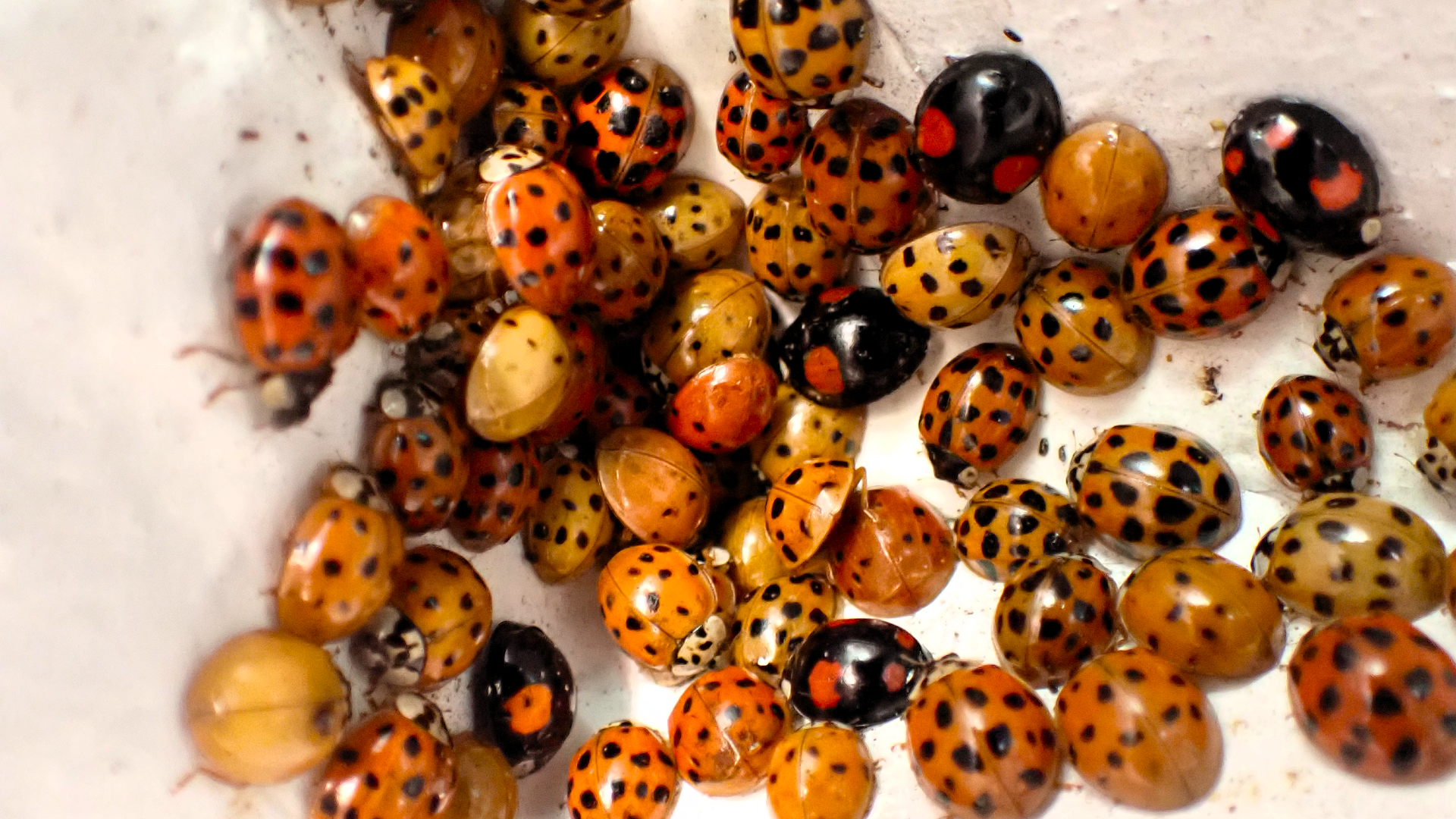
© Raymond Small TQ4792 18/10/2024
As the weather cools ladybirds get prepared for hibernation, a period of suspended development in insects known as diapause. Some species do this alone in cracks while others form large clusters in sheltered places. When the diapause ends with the warm spring weather they will wake up to mate and egg lay.
EUROPEAN PEAR RUST
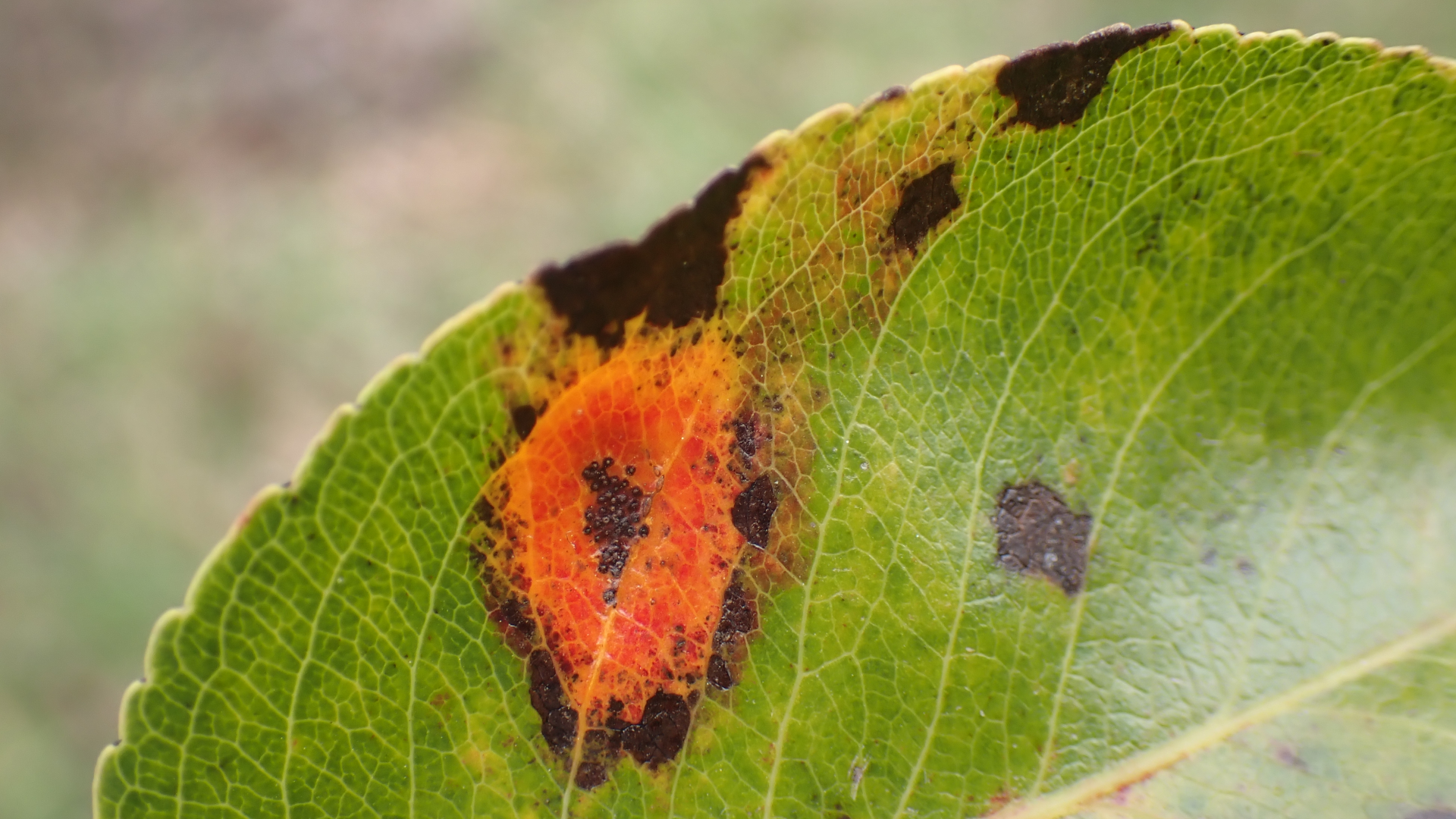
© Raymond Small TQ4792 06/10/2024
Gymnosporangium sabinae
Juniper trees play host to this fungus during winter and pear trees become the secondary host in the summer. This rust fungus needs both juniper and pear trees to complete its life cycle. On pear trees the fungus creates orange patches on the upper surface of leaves.
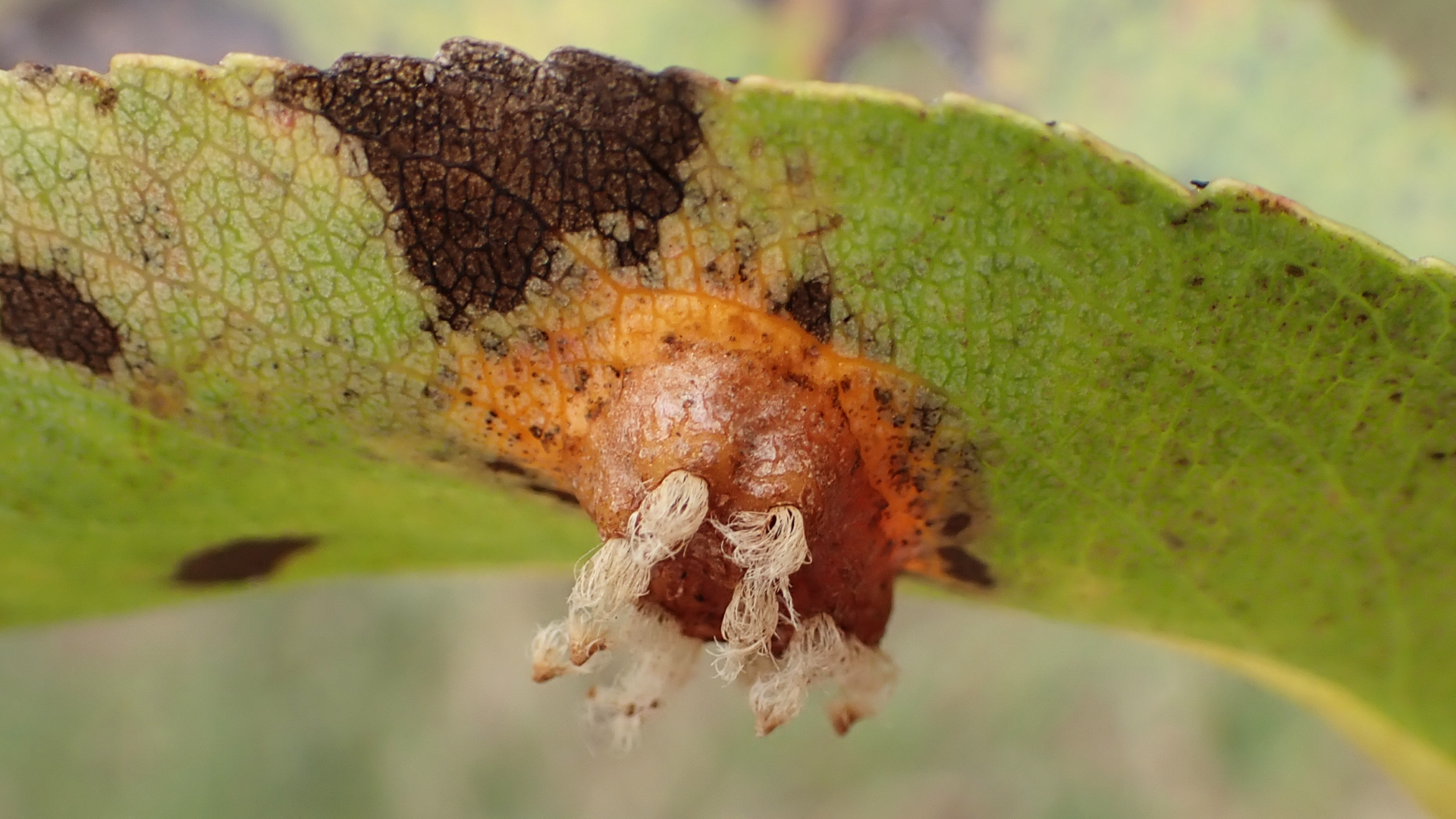
© Raymond Small TQ4792 06/10/2024
Blisters appear on the underside of pear leaves in which spores develop. The spores are spread by the wind to infect juniper trees.
COMMON PARASOL
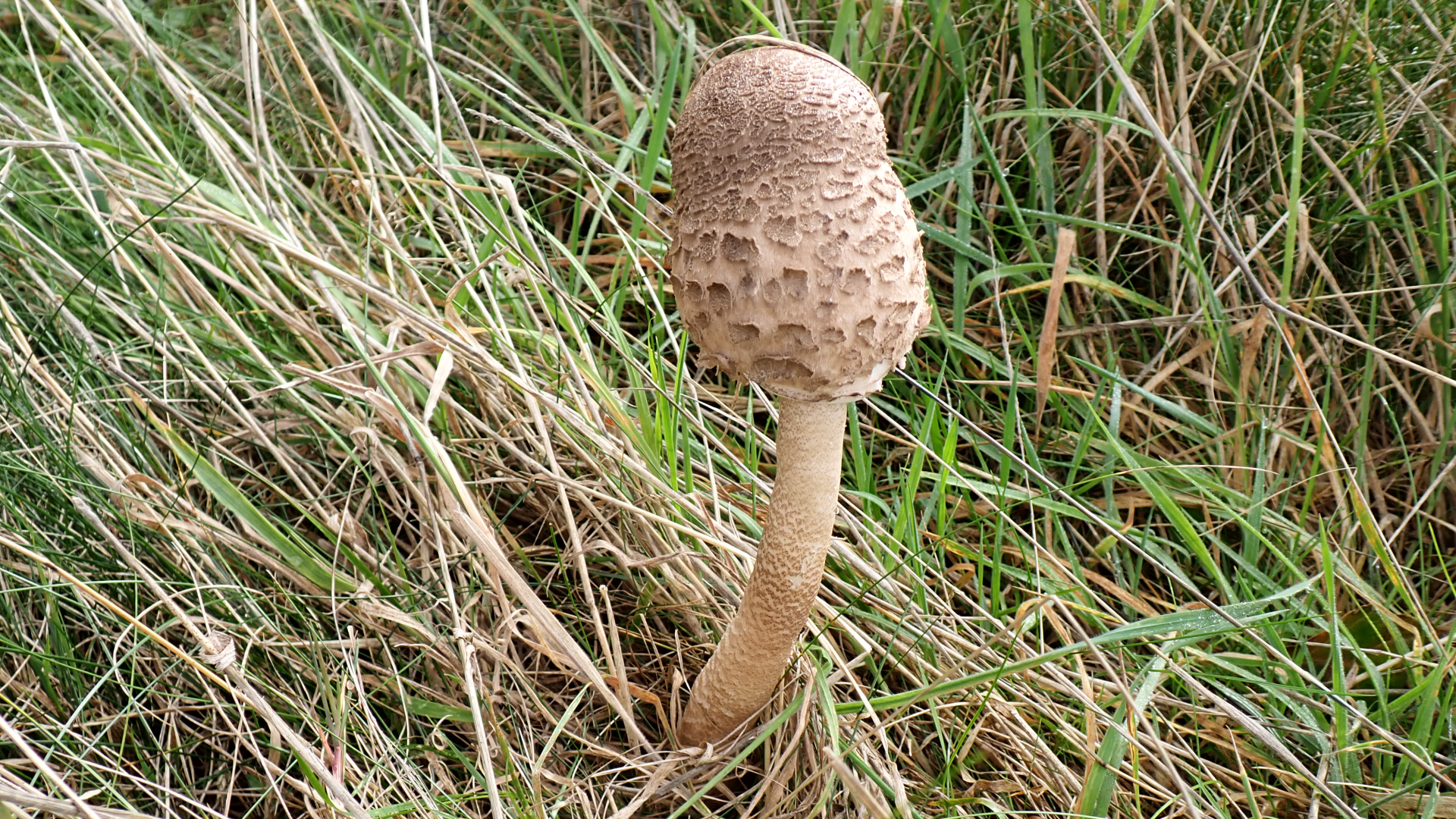
© Raymond Small TQ4892 06/10/2024
Macrolepiota procera
The Common Parasol has a whitish-buff cap covered with large dark brown scales. The cap is initially egg-shaped, flattening and developing a dark central bump.
TROOPING FUNNEL
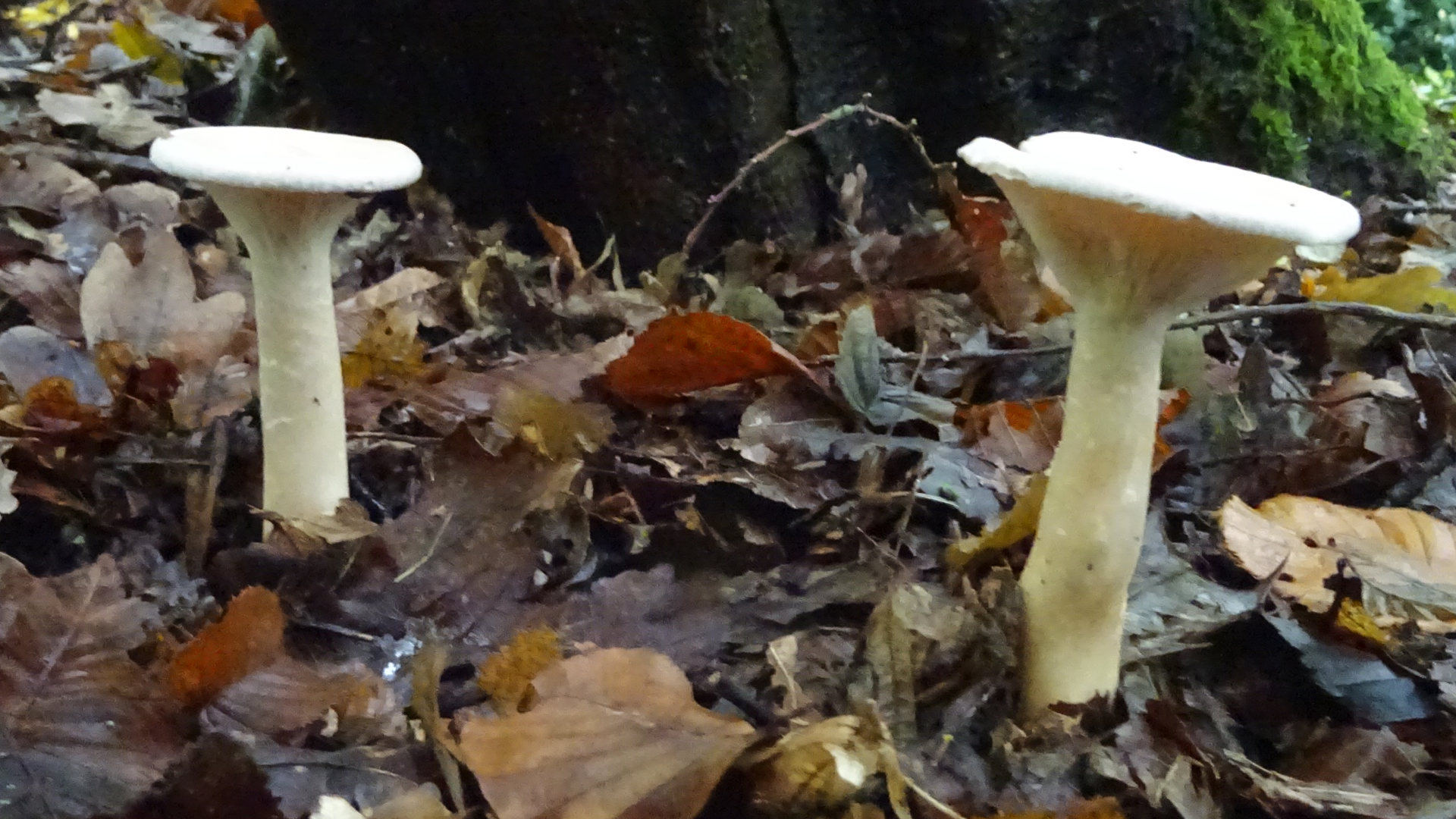
© Raymond Small TQ4793 15/10/2024
Clitocybe geotropa
Trooping Funnels often grow in rings in deciduous woodland, although occasionally solitary mushrooms occur. The creamy-buff caps are typically 10-15cm across when fully grown with a fairly broad central umbo on top.
WITCHES' BUTTER
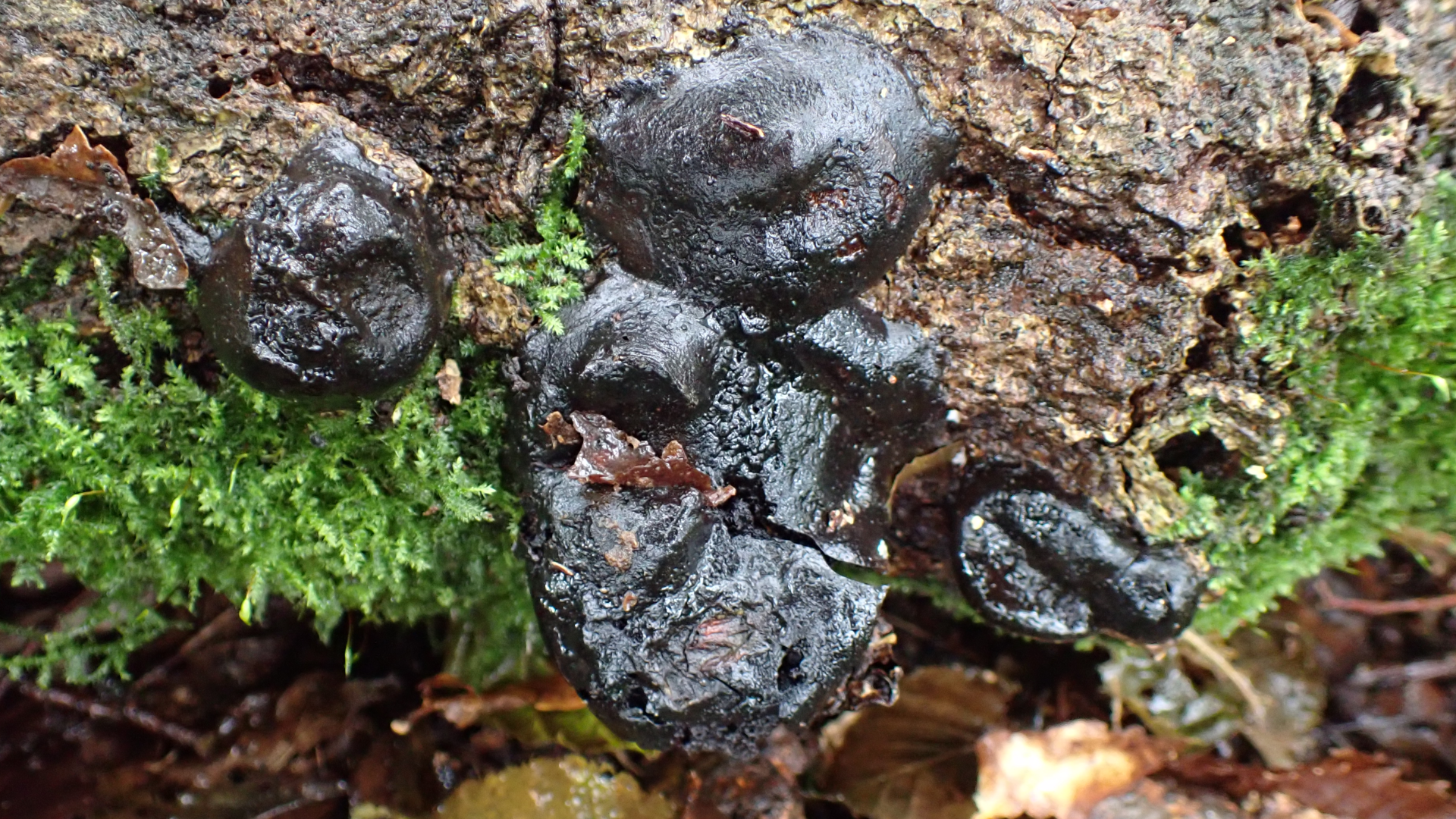
© Raymond Small TQ4792 10/10/2024
Exidia glandulosa
Witches' Butter appears on deciduous dead wood during autumn and winter. The fruiting bodies attach to the wood using tiny stems. More noticeable after prolonged wet weather when they become plump and fleshy.
ROSY BONNET
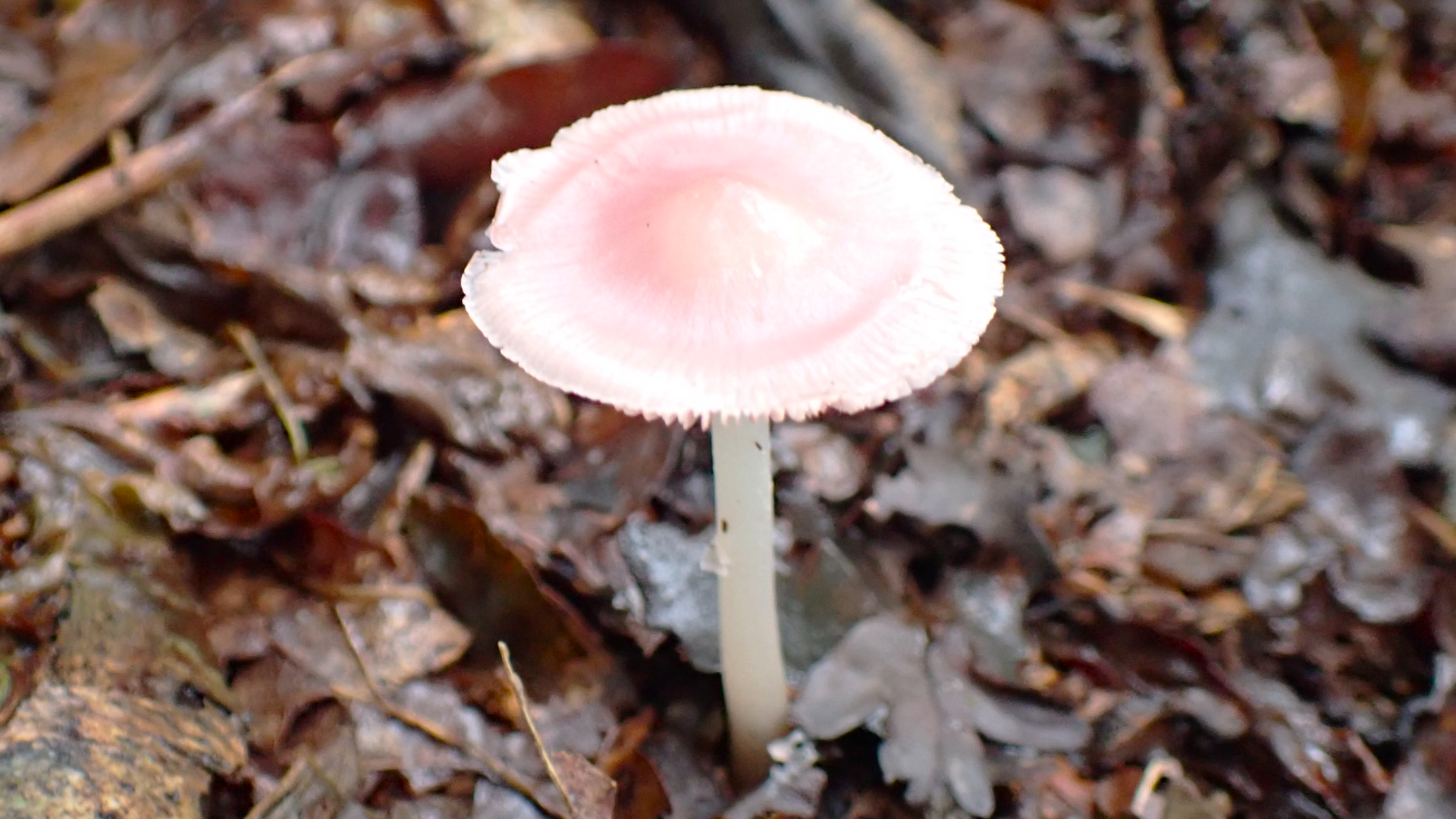
© Raymond Small TQ4793 10/10/2024
Mycena rosea
The Rosy Bonnet is a common woodland species often found in leaf litter. Caps measure up to 60mm in diameter and are pinkish with a whitish margin.
DOGWOOD
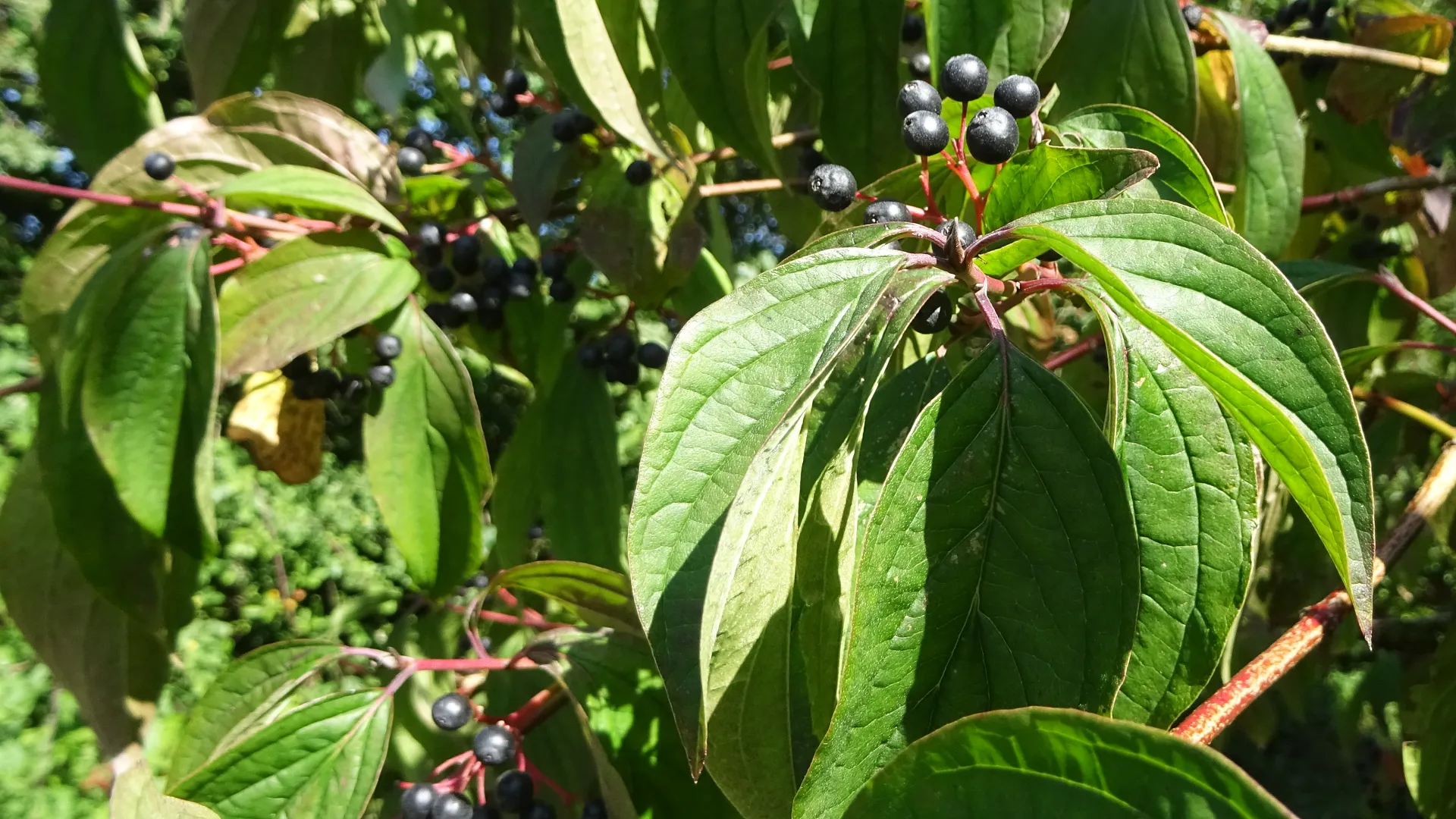
© Raymond Small TQ4692 15/09/2024
Cornus sanguinea
A common red-stemed shrub found in hedgerows. In autumn it develops black berries and as winter approaches the leaves will turn deep crimson. Some dogwood species have edible berries and others are poisonous to humans and animals.
Dwarf Gorse
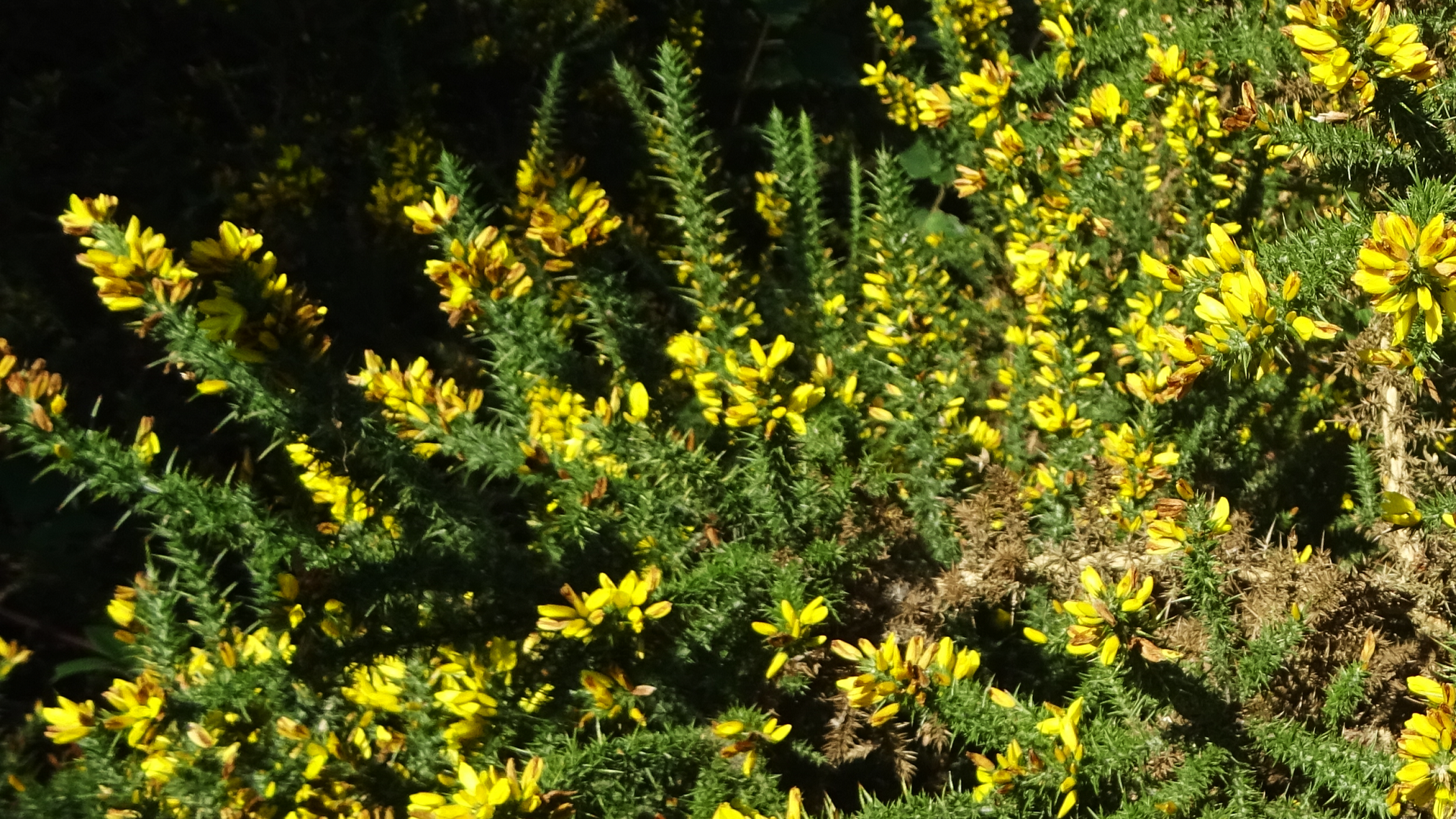
© Raymond Small TQ4693 15/09/2024
Ulex minor
Dwarf gorse is a low-growing evergreen shrub mainly restricted to heathland habitats. It normally grows about 30 centimetres high, but in shaded, ungrazed locations it can grow to one metre tall. It is often found with heather. One of the plants growing well in the heathland.
HEATHER
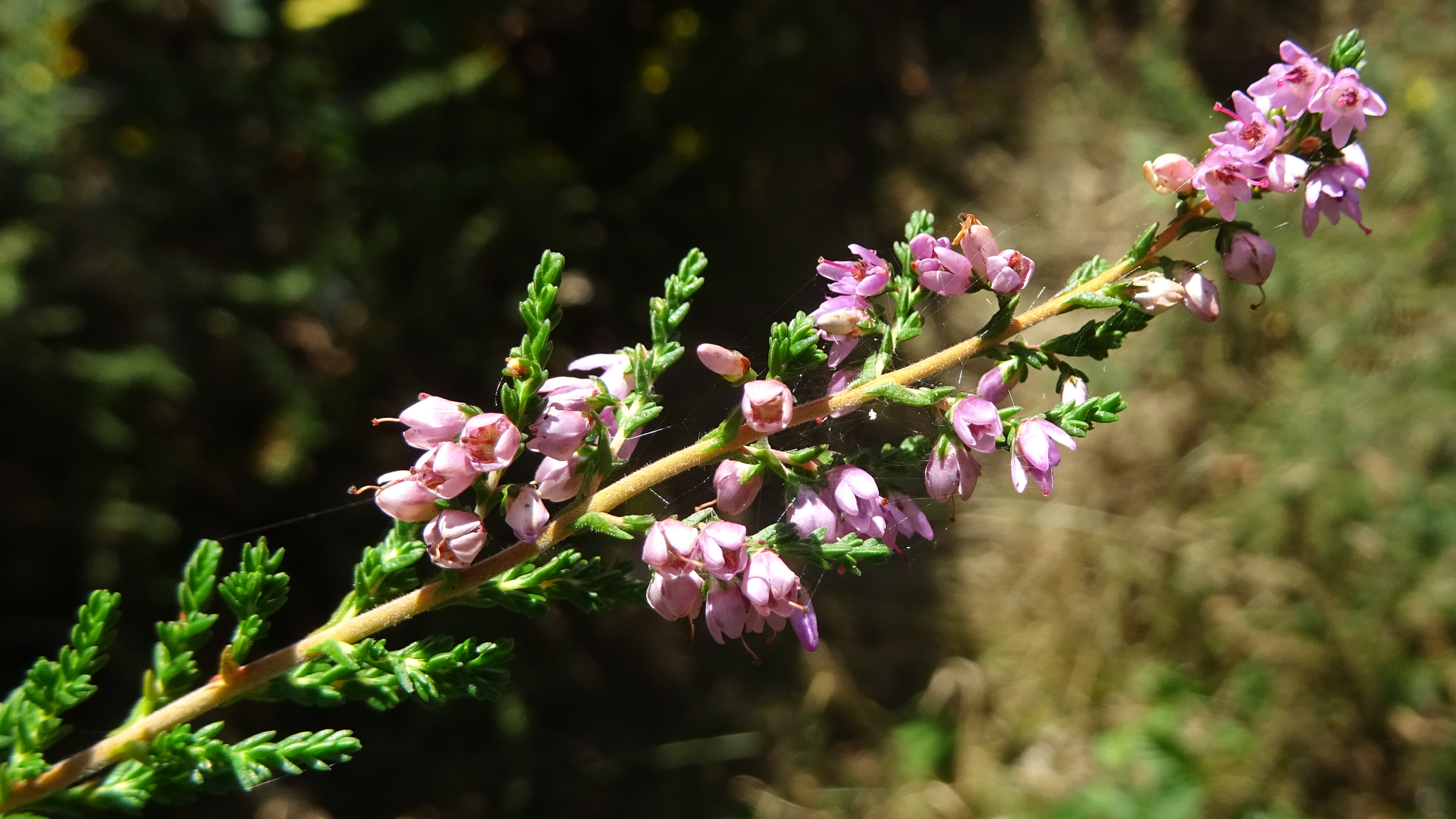
© Raymond Small TQ4693 15/09/2024
Calluna vulgaris
It has been a poor time for recording plants in the Heathland located in the corner of the forest at Chigwell Row. The Heather is now struggling to survive and the Slender St. John's Wort, Fox and Cubs and Petty Whin haven't been recorded this year.
MIRID BUG
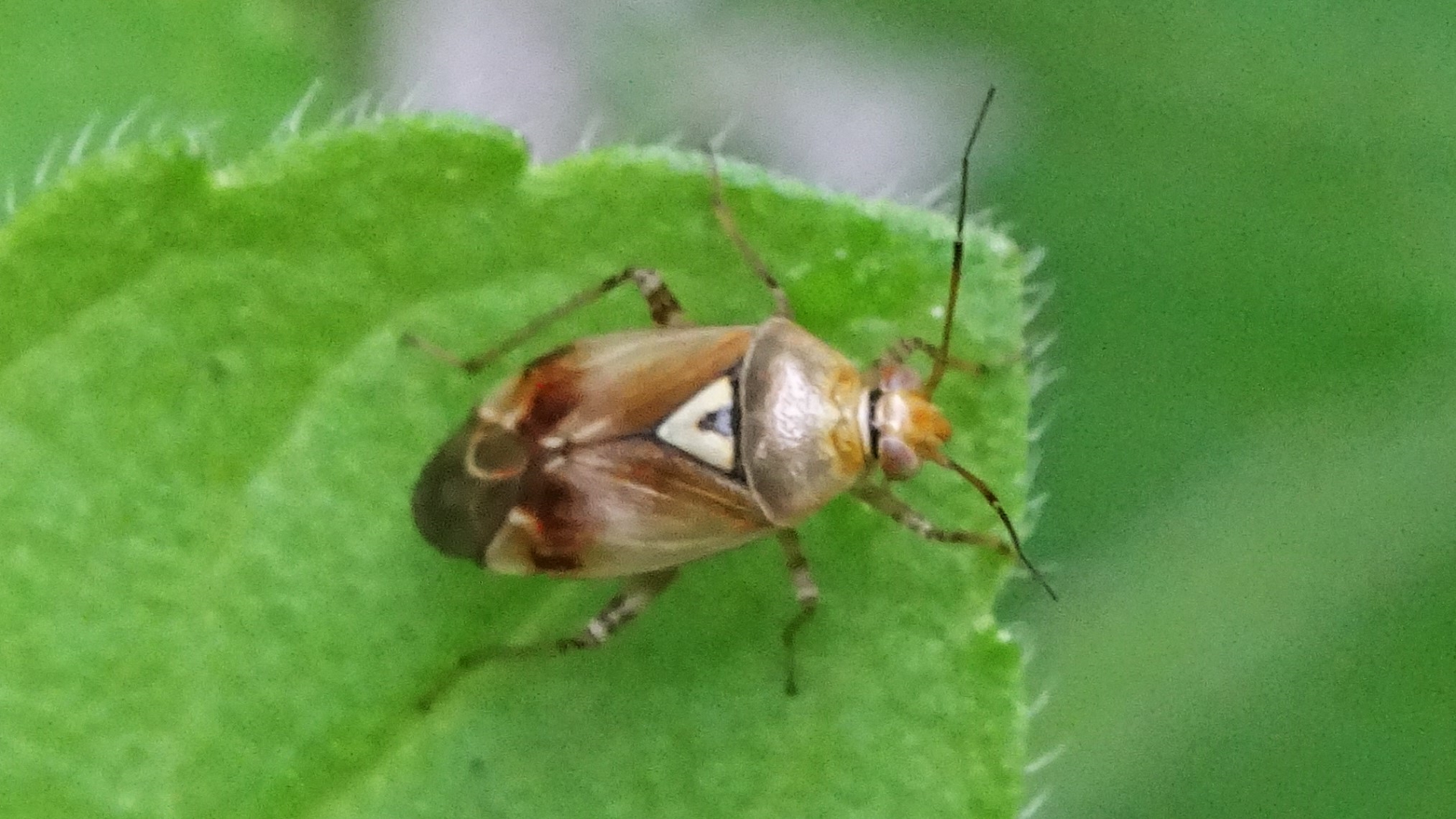
© Raymond Small TQ4793 07/09/2024
Lygus sp.
This family of mirid bugs are very difficult to identify. There are five UK species that overlap greatly in colour, markings and size. Only by examining the fine detail of the middle of the corium at high resolution can a reliable identification of a species be made. Adults are usually 6-7mm in length.
MARSH FLY
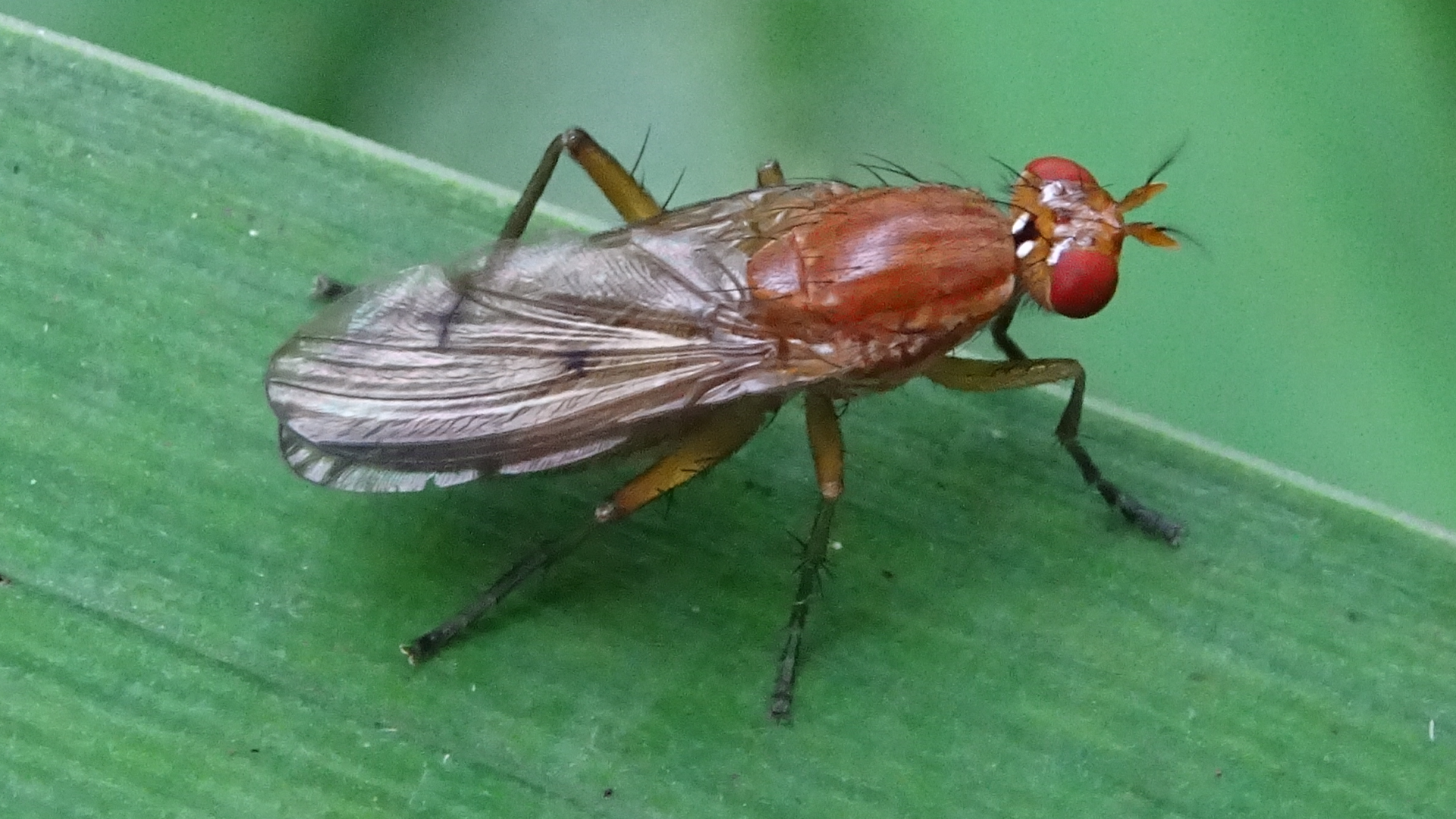
© Raymond Small TQ4793 07/09/2024
Tetanocera sp.
There are at least 50 described Marsh Fly species in the genus Tetanocera. They are common around small ponds such as Sheepwater and Roes Well.
SCORPIONFLY
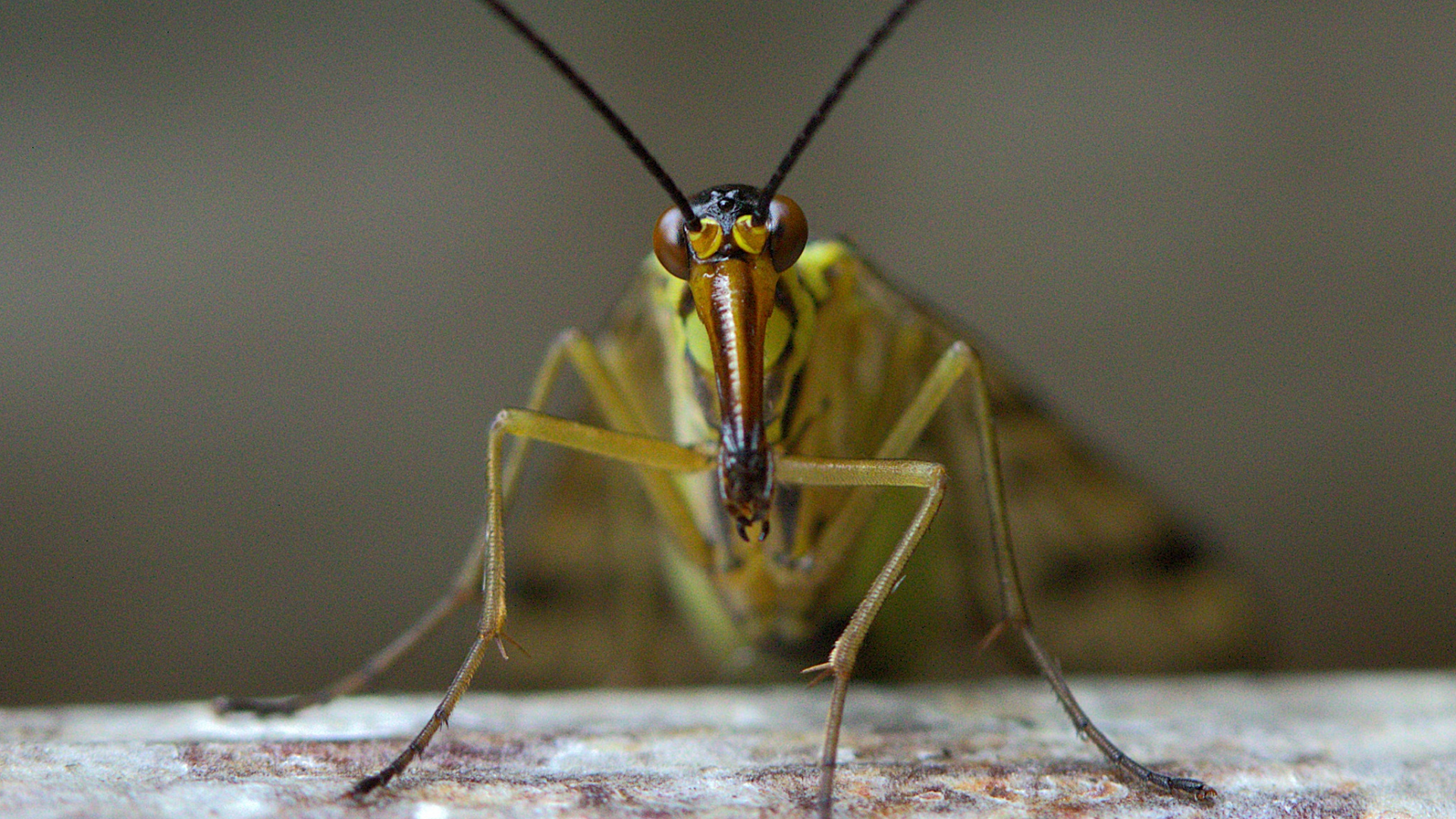
© Mike Rumble TQ4793 10/08/2024
More next month. That's all folks!
Thank you to everyone that has contributed with pictures, emails, information and identifications.
THOMAS THE TANK ENGINE
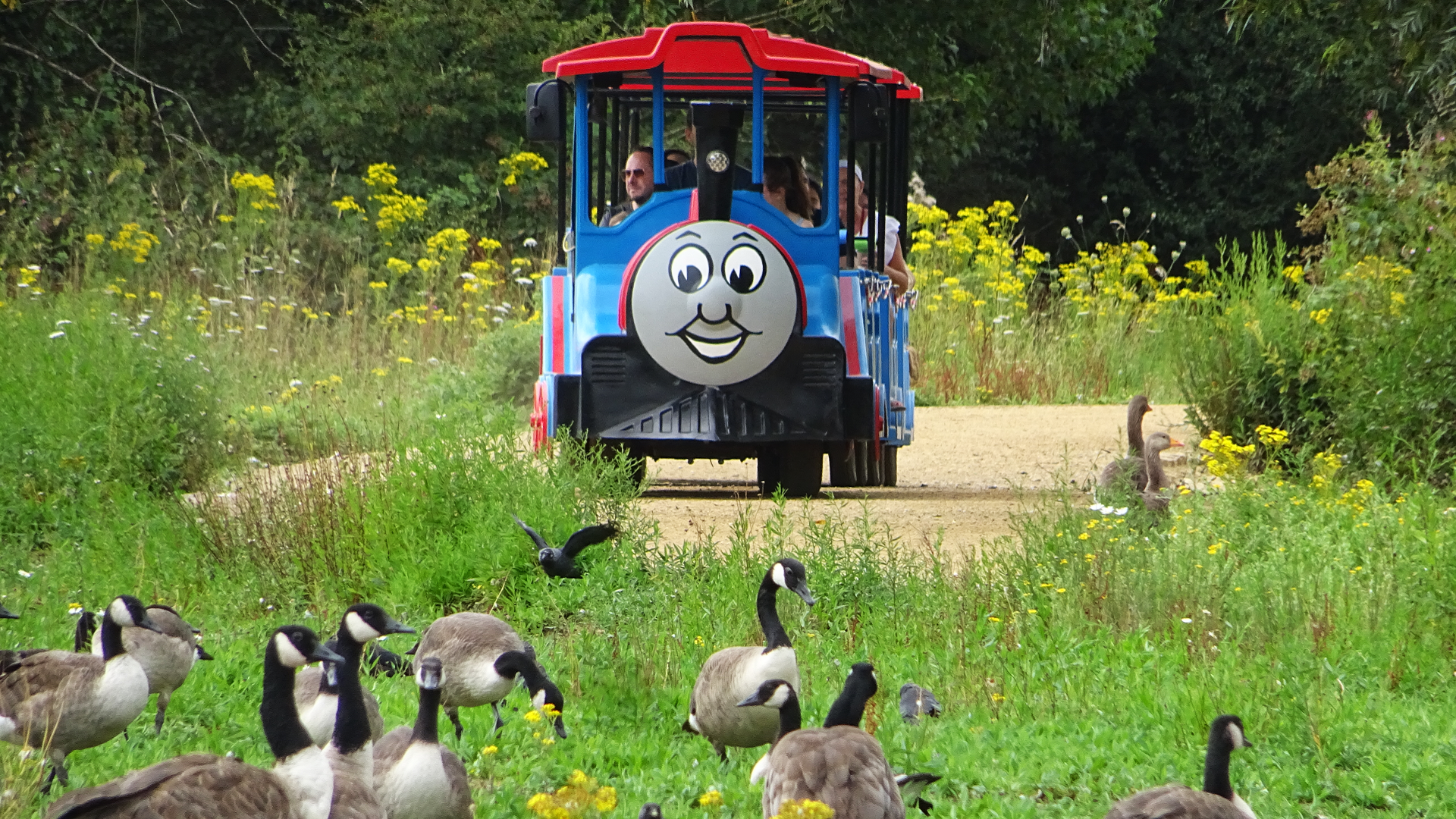
© Raymond Small TQ4792 03/08/2024
"Hello Geese!" shouted Thomas, as he rounded the bend. "Honk! Honk!", the Geese replied. Thomas was excited: "I'm dropping these passengers off at the 1856 Cafe and then picking up some more. This route around the lake is very popular during the school holidays!"
COMMON RED SOLDIER BEETLE
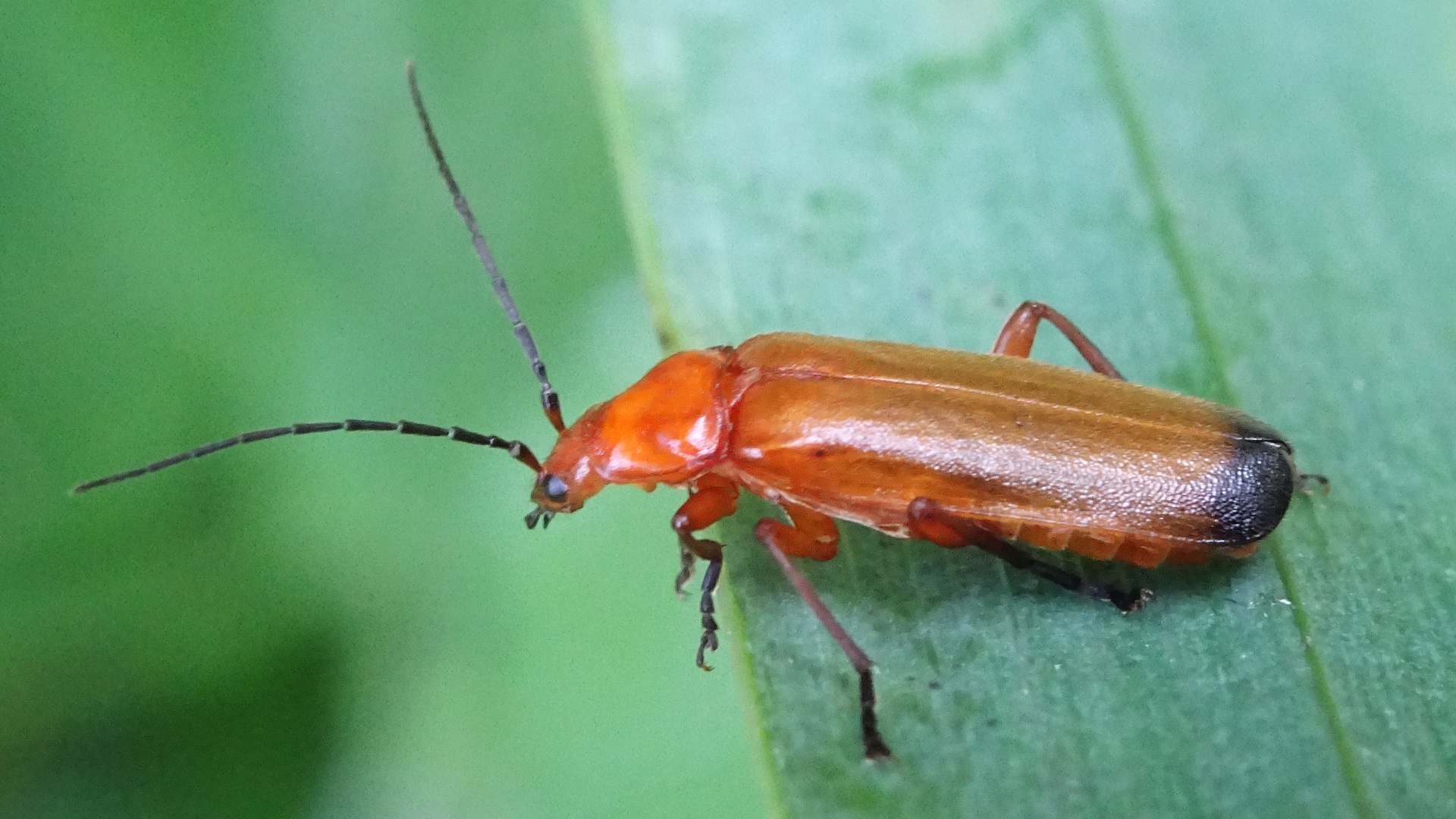
© Raymond Small TQ4793 12/08/2024
Rhagonycha fulva
This common beetle in often found on hogweed and cow parsley during July and August. They feed on nectar and pollen and also eat other insects that visit the flowers they are resting on.
LONG-WINGED CONEHEAD
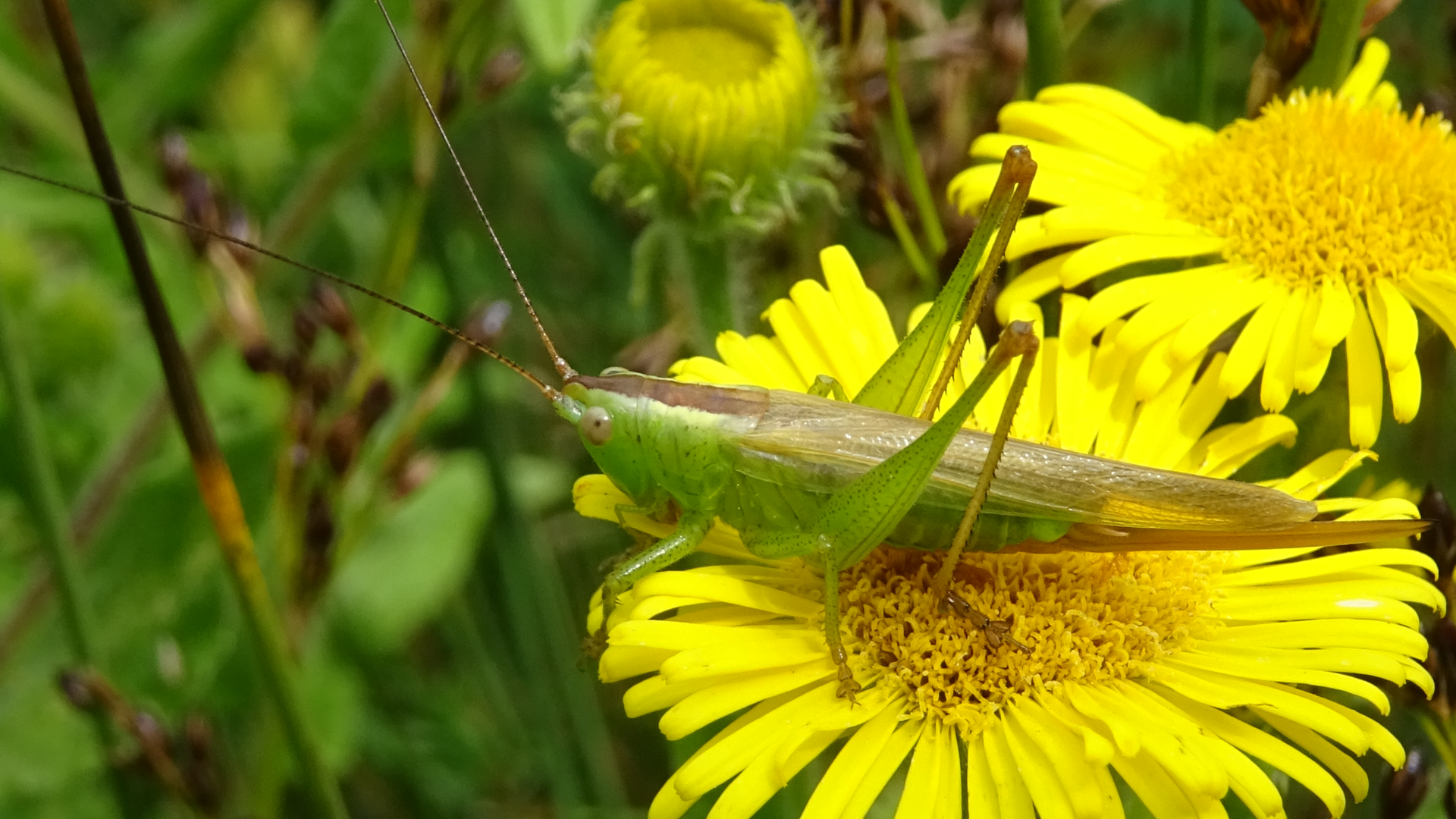
© Raymond Small TQ4792 03/08/2024
Conocephalus fuscus
These bush-crickets mainly feed on grass and sometimes small invertebrates. The common name is derived from the angled shape of the head. Females have a large ovipositor sticking out at the rear that is used to lay eggs. Adults are about 20mm long. Nymphs have short wings and a black stripe along the back.
NON-BITING MIDGE
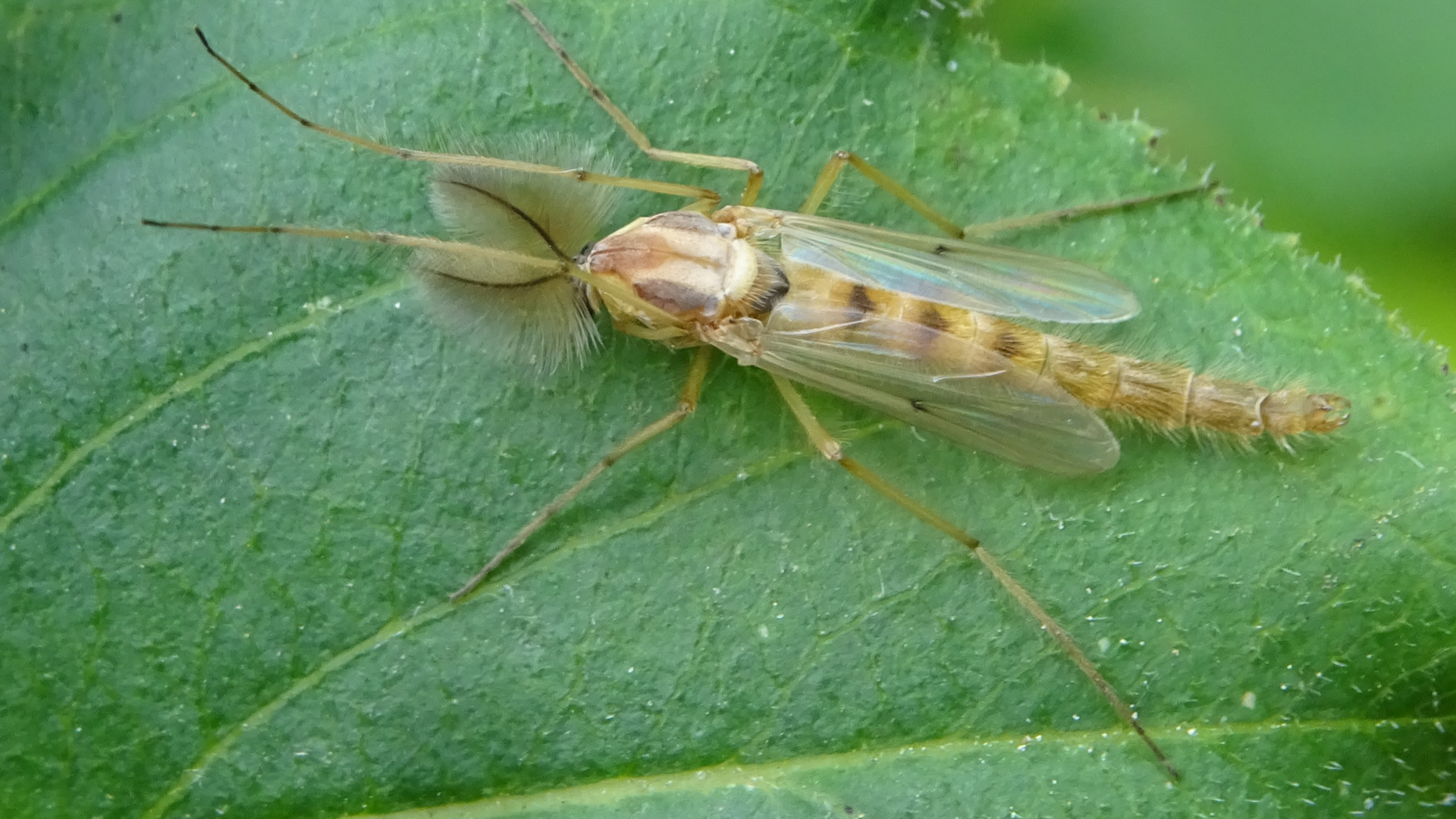
© Raymond Small TQ4792 03/08/2024
Chironomus agg,
Non-biting midges are found around water when females are ready for egg laying. Their larvae, known as 'bloodworms', live at the bottom of lakes and rivers. Males have prominent plumes on the head.
THE ODD COUPLE
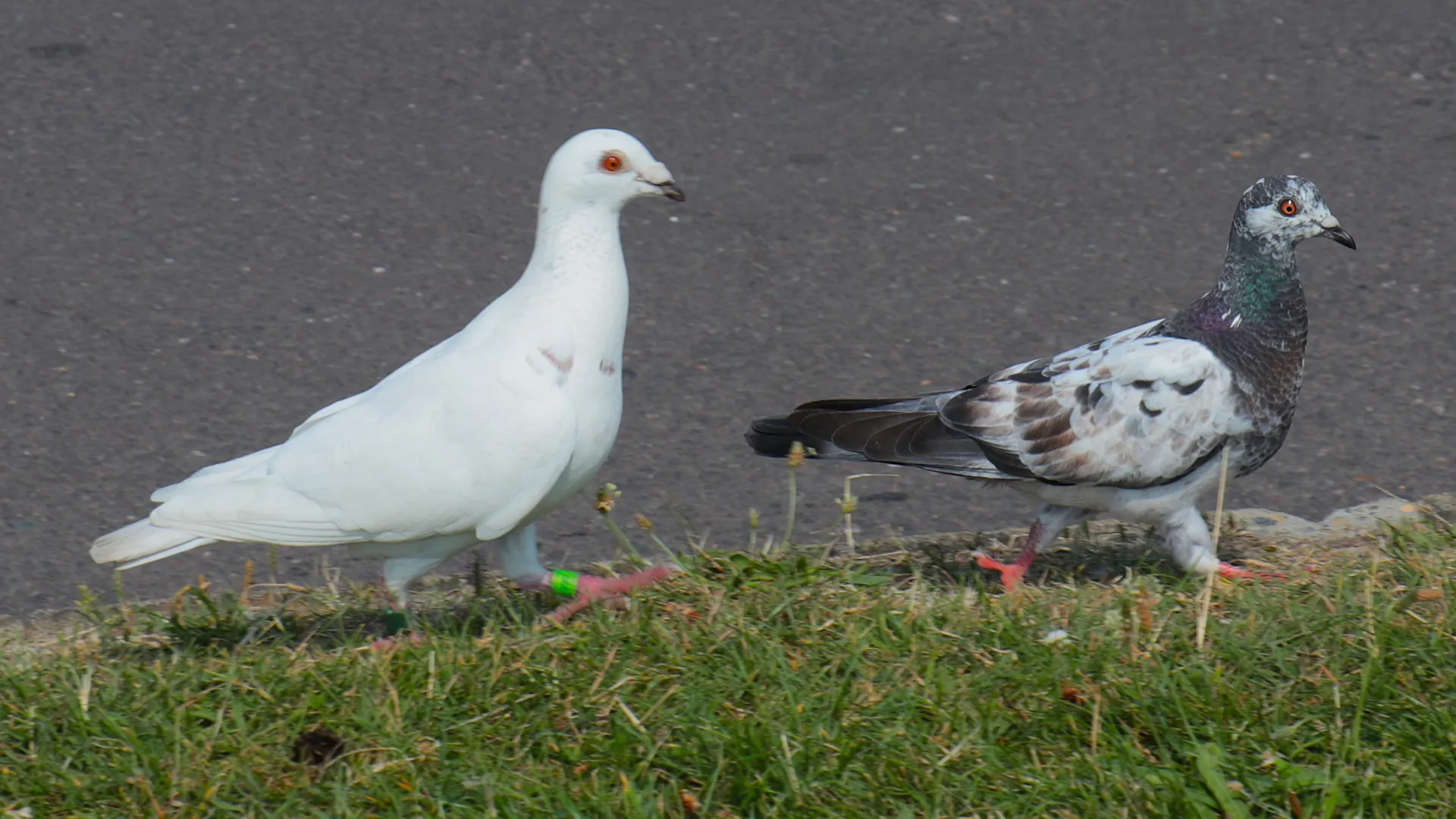
© Mike Rumble TQ4792 01/08/2024
Columbidae
Doves and pigeons belong to the same bird family and share similar characteristics. Doves are generally smaller, pigeons are often larger and stockier, although this distinction is not consistent. This unusual pair were spotted by Foxburrow Road.
WINTER 2024-25
GULLS

©Raymond Small TQ4792 13/01/2025
Black-headed Gulls are seen at Hainault lake throughout the year, but are more numerous during the winter. They have a dark spot on the side of the head which totally covers the head when the breeding plumage occurs in the summer. They are often accompanied by an occasional Common Gull or Lesser Black-backed Gull, which can usually be easily picked out from the crowd by their larger size and different coloured legs.
PEAHENS
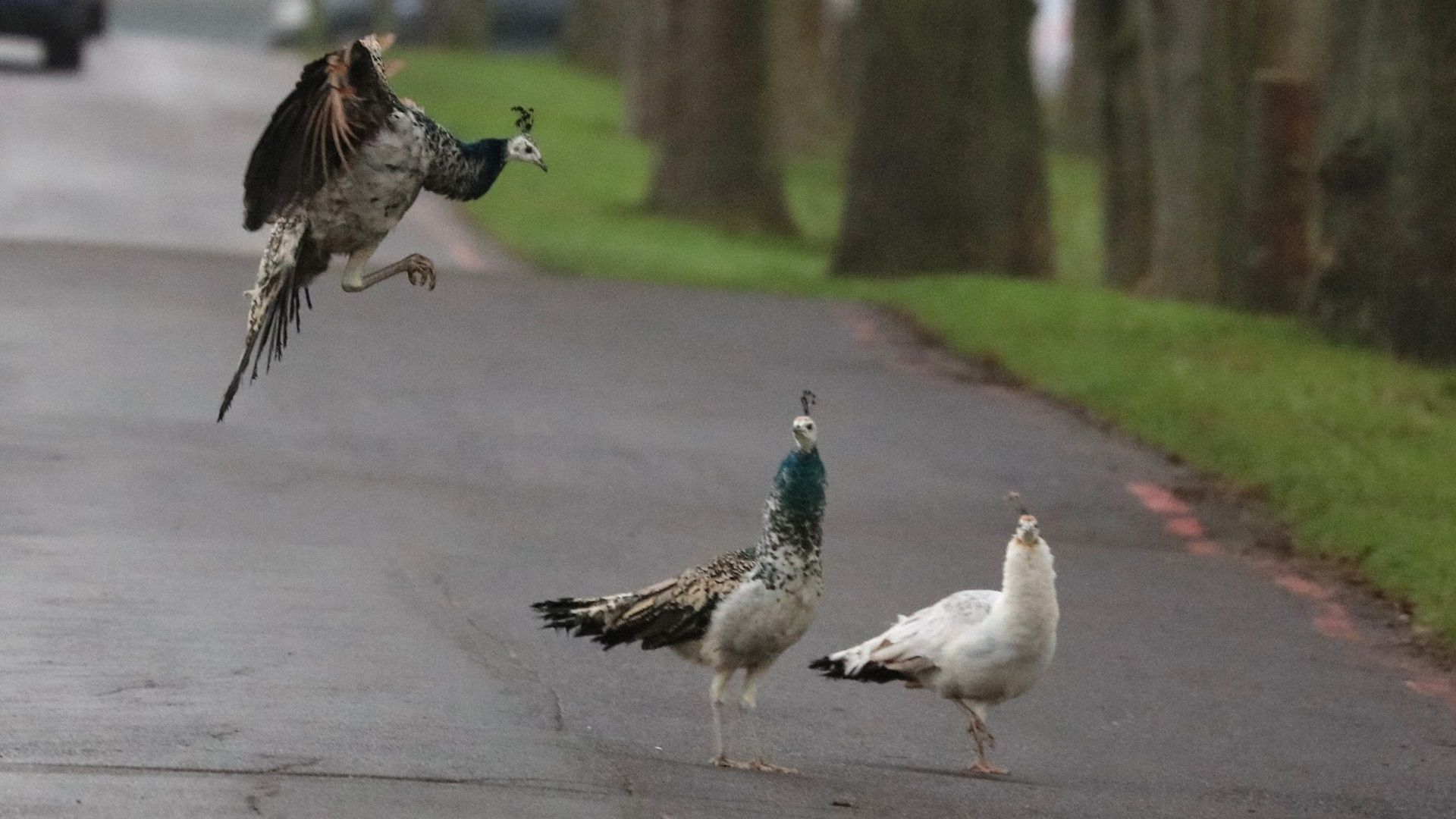
©Michael Trump TQ4792 29/12/2024
Peahens making their great escape from Foxburrow Farm. In captivity peacocks and peahens usually feed on seed, grain, fruit, other plant matter and insects. In the wild they have also been known to consume small mammals, reptiles and amphibians.
VAPOURER MOTH
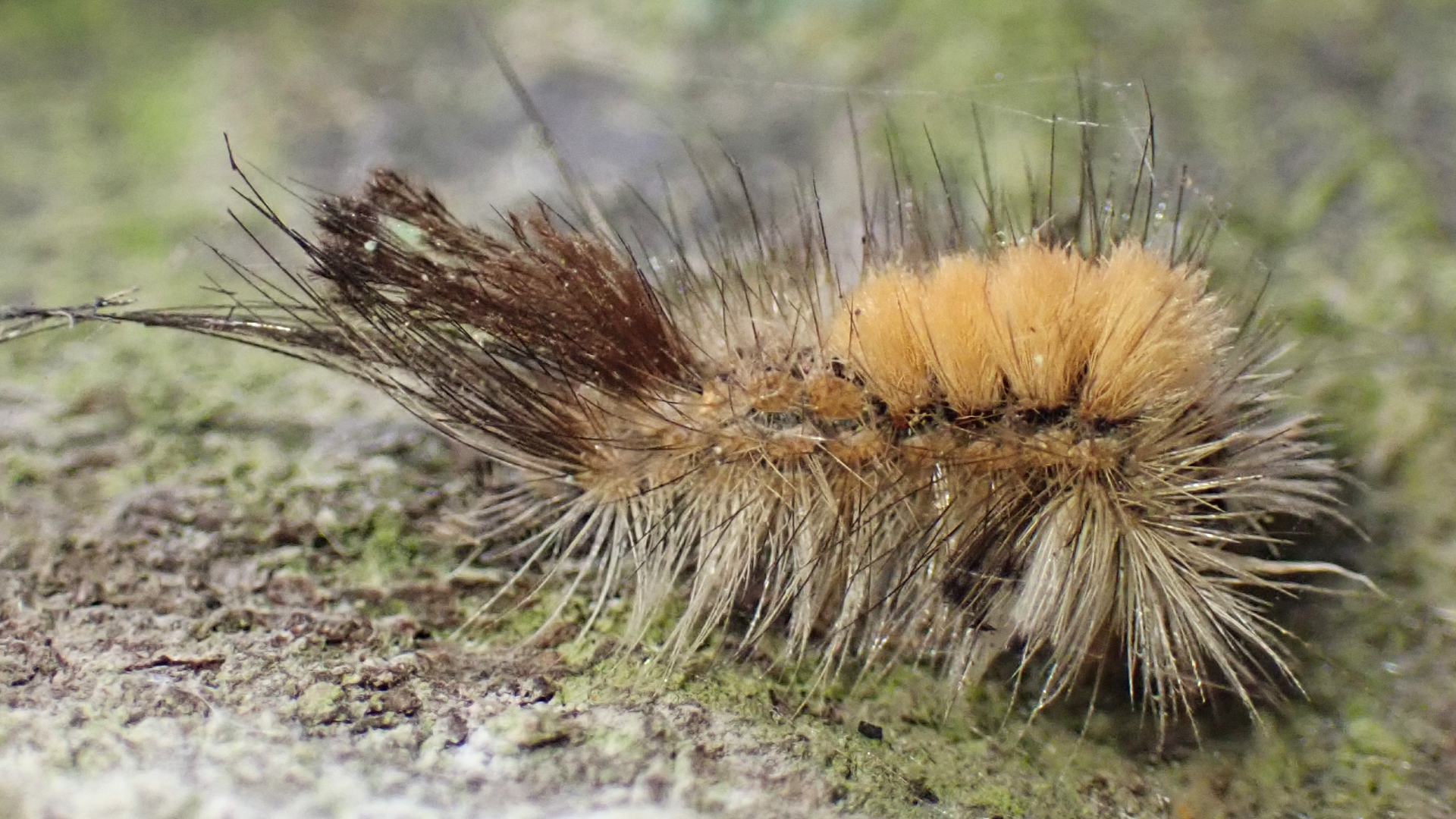
©Raymond Small TQ4792 31/12/2024
It is often claimed that Vapourer caterpillars are seen from May until September so this young larva (1 cm long) was an unexpected find at the end of December. Moults of caterpillars have been seen at this time of year, but this one was moving meaning that this larvae was alive and kicking.
HAZEL COPPICE
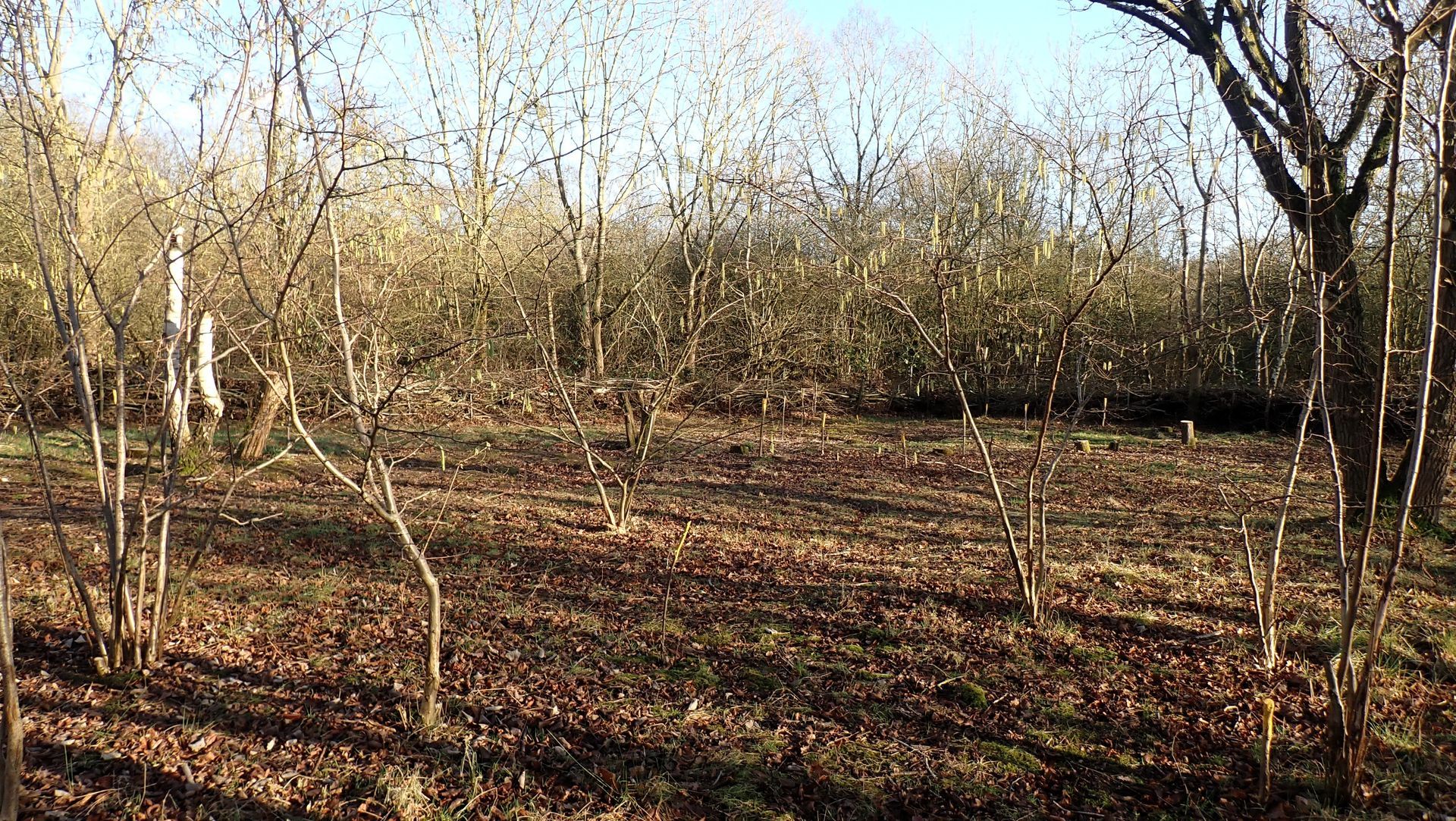
©Raymond Small TQ4692 02/01/2025
This area was overgrown with bramble and difficult to walk through. When pointed out to the forest rangers that this was once a Hazel plantation they decided the area needed special attention, so with the assistance of volunteers they cleared the undergrowth and coppiced many of the trees. Coppicing is a process that dates back to Stone Age times. Trees are felled at the base to allow new shoots to grow. This was originally done to produce timber that could be used for firewood or building a dead hedge. A dead hedge has been build around this area utilising the wood produced by coppicing.
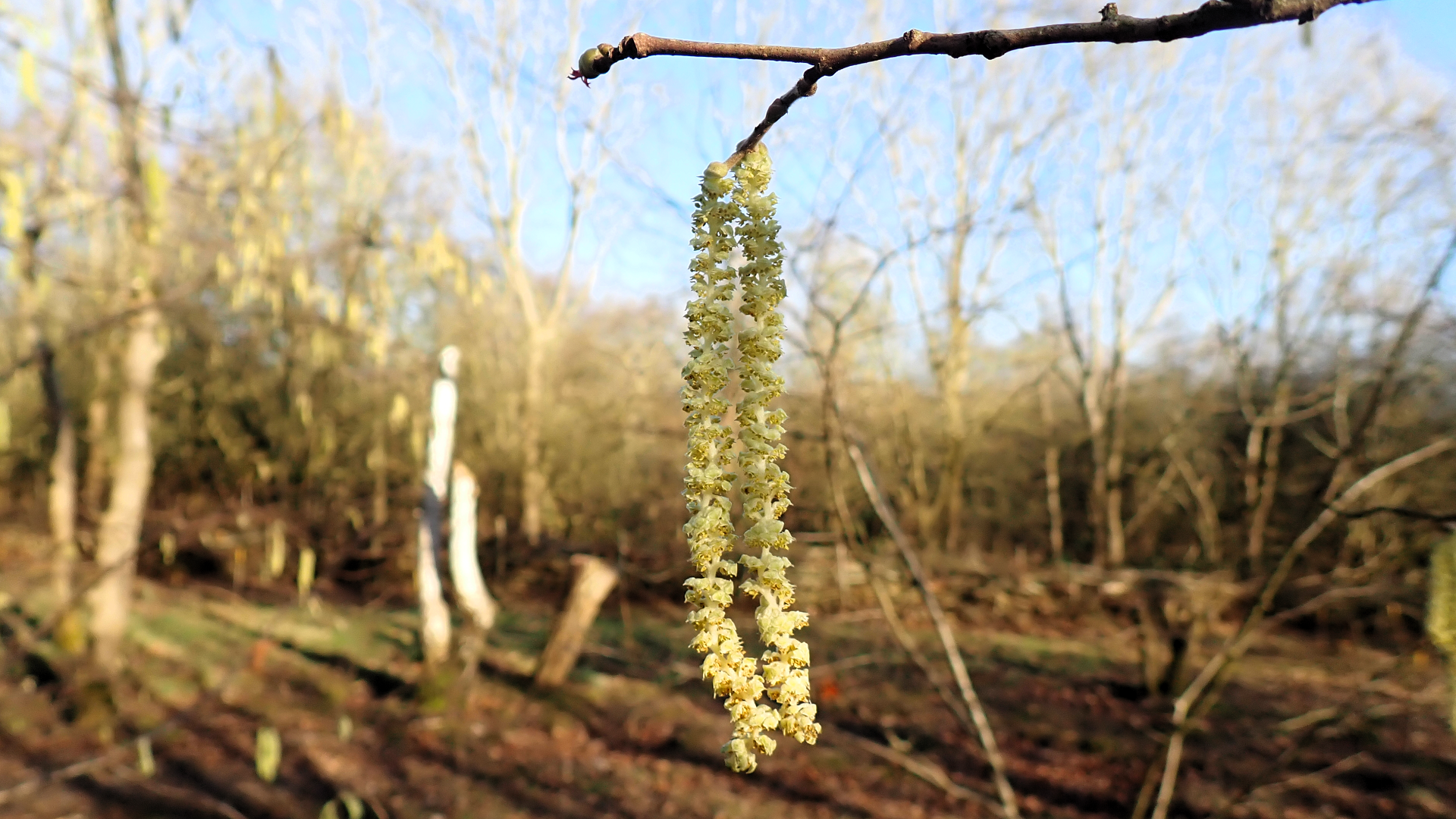
©Raymond Small TQ4692 02/01/2025
Nowadays coppicing is usually done to improve the health and biodiversity of woodland. Opening up the canopy to allow sunlight in is beneficial to species at ground level. It allows more woodland plants to thrive which in turn helps other wildlife. Trees are often cut in rotation with wood harvested in a section one year, another section the next, and so on. Hazel is normally coppiced on an eight-year cycle. Coppicing can greatly extend the life of a tree.
The long, hanging, male flowers known as 'catkins' produce pollen. Female flowers are very small and often go unnoticed. Can you see the female flower in this picture?
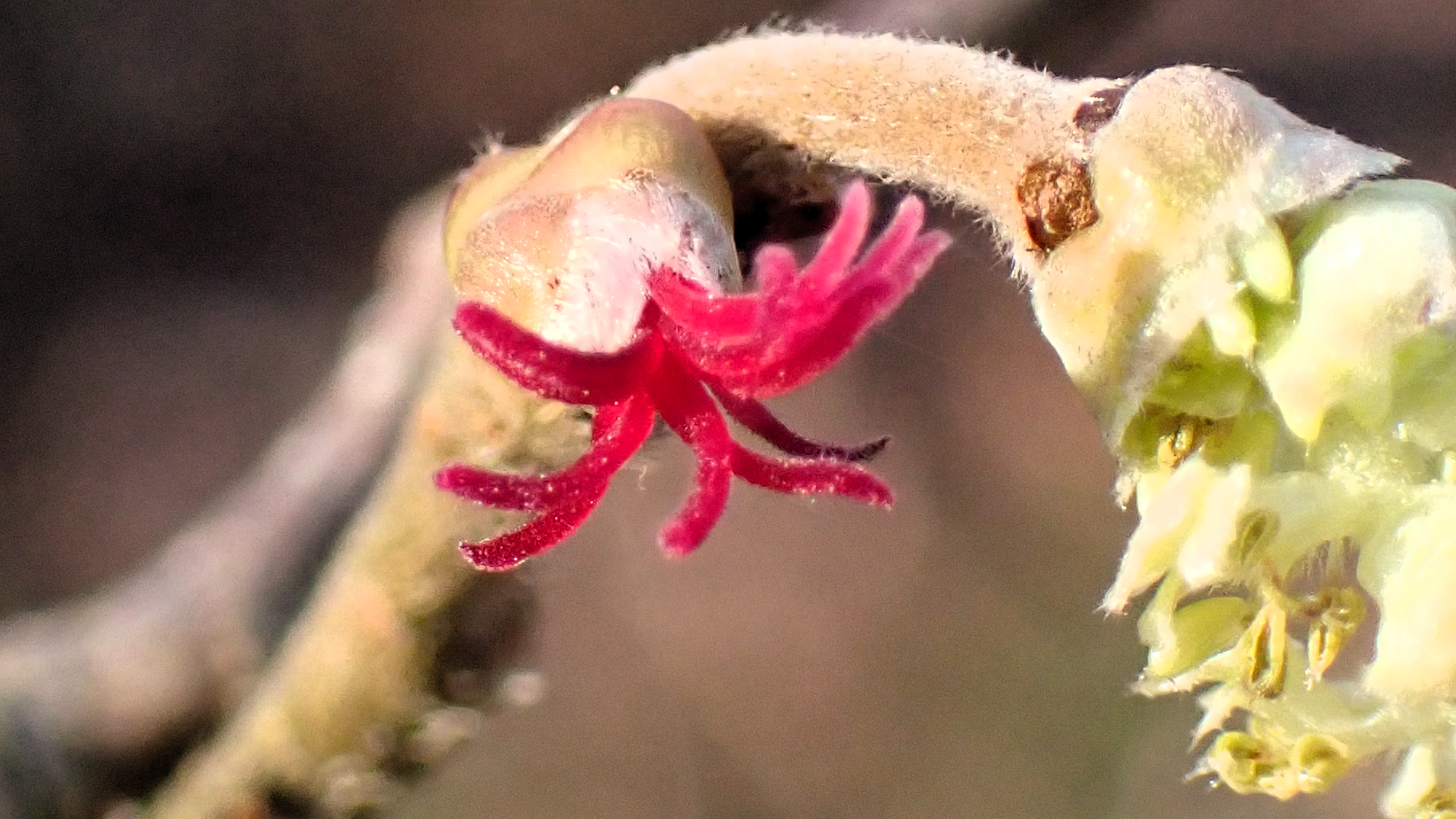
©Raymond Small TQ4692 02/01/2025
The beautiful red styles belonging to this female flower are only about 4mm long. A hazel tree contains both male and female flowers (monoecious) but needs to cross-pollinate with another tree to produce nuts.
HOLLY
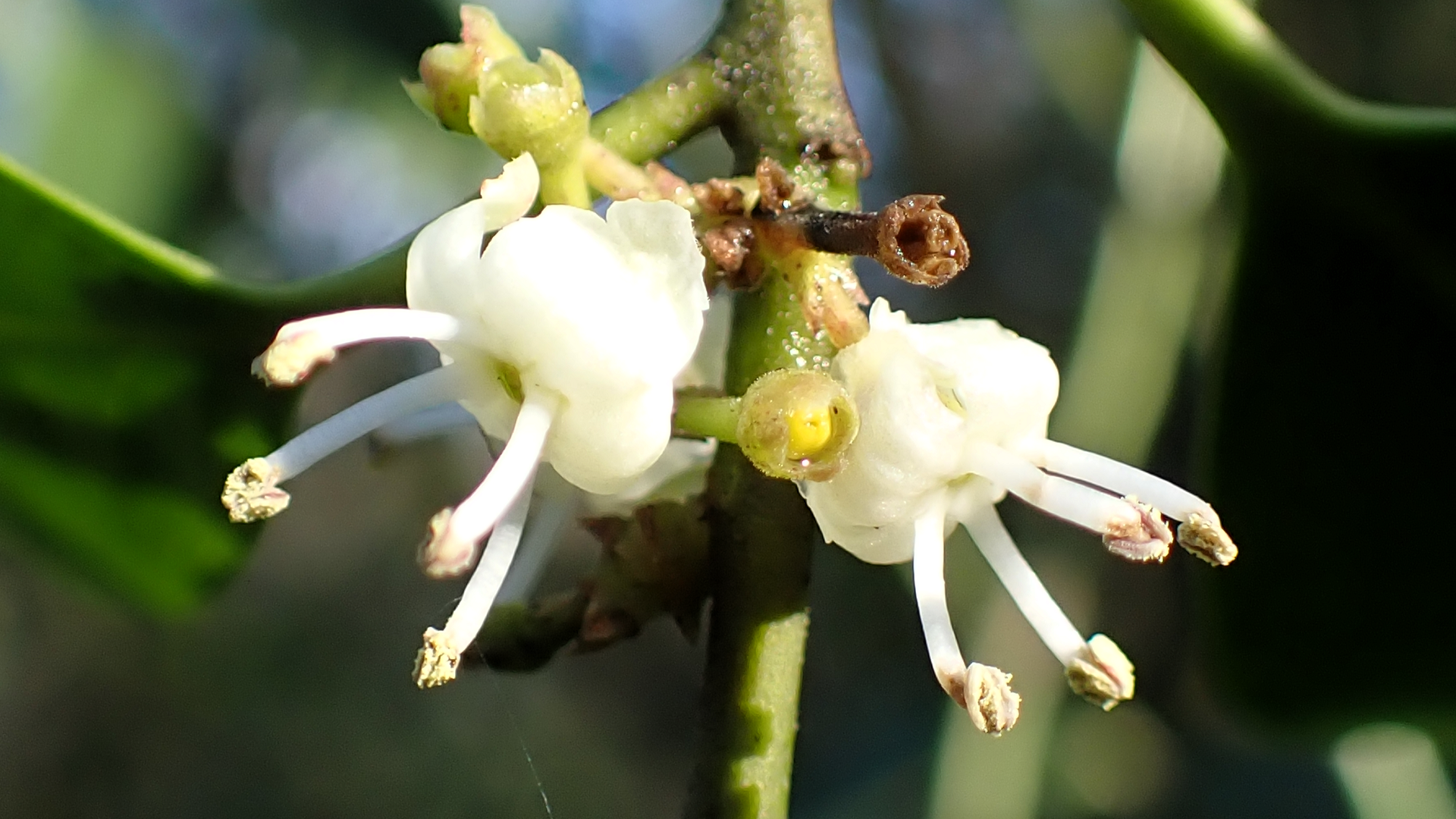
©Raymond Small TQ4793 02/01/2025
Holly has creamy-white flowers which are either male or female. Male flowers have prominent pin-like structures that produce pollen called stamen. Female flowers have four stamen that don't produce pollen. Holly plants are dioecious, meaning they require separate male and female plants in order for pollination to take place. In the middle of a female flower there is a fat green ovary, once the flowers are pollinated they develop into bright red berries. Berries only grow on female plants. Female leaves have serrated edges, male leaves are often straighter and plainer.
CONES
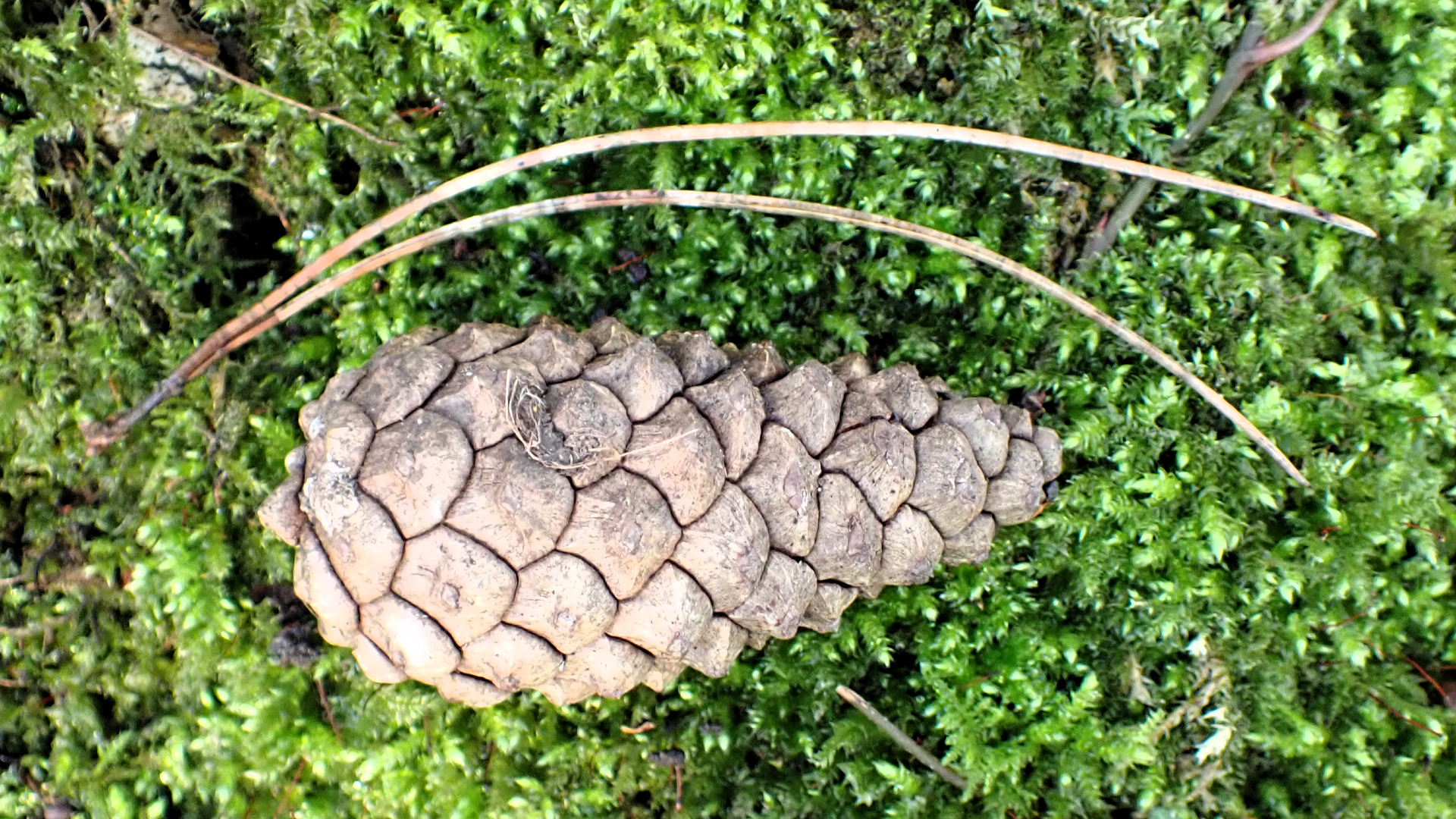
©Raymond Small TQ4791 03/01/2025
Pine trees have woody fruiting bodies called cones, which can be either male or female. Male cones usually have a relatively short existence and being small often go unnoticed. Female cones are larger and more conspicuous. Initially the cones are green later turning brown. During spring male cones appear in clusters at the tips of the branches each one loaded with pollen which is dispersed on the wind. Pollen enters the female cone and after pollination has taken place seeds develop. Seeds can take 2-3 years to form. When mature the seeds are dispersed on the wind and by the animals that eat them. Female cones open only when the weather is suitable for the seeds to be spread. They close up in wet weather to protect the seeds and open up again in drier conditions. The above picture shows a Scots Pine cone.
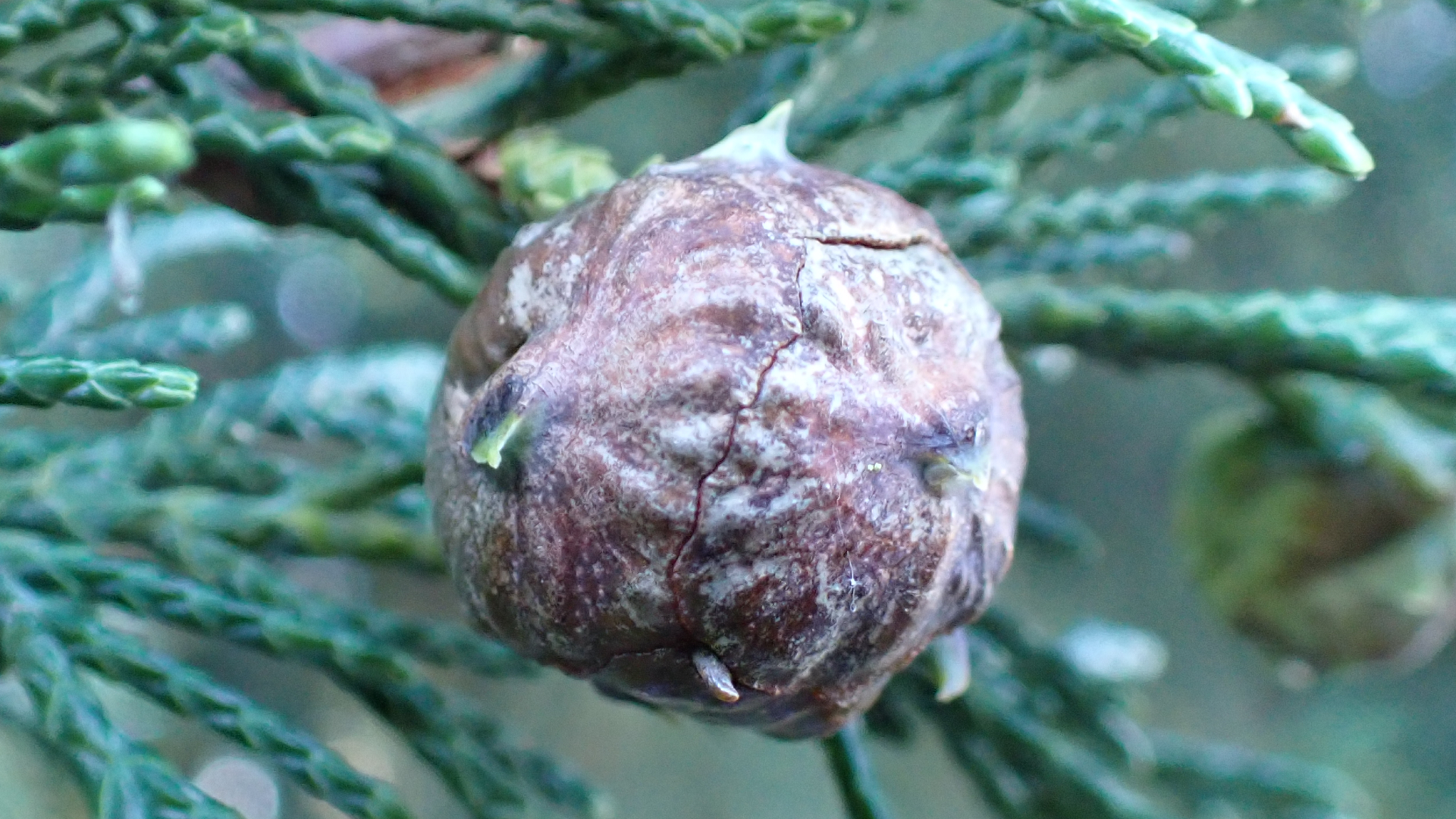
©Raymond Small TQ4892 02/01/2025
Cones can be conical or round-shaped. This spherical cone belongs to a Cypress tree. There are several Cypress trees on Hainault Golf Course.
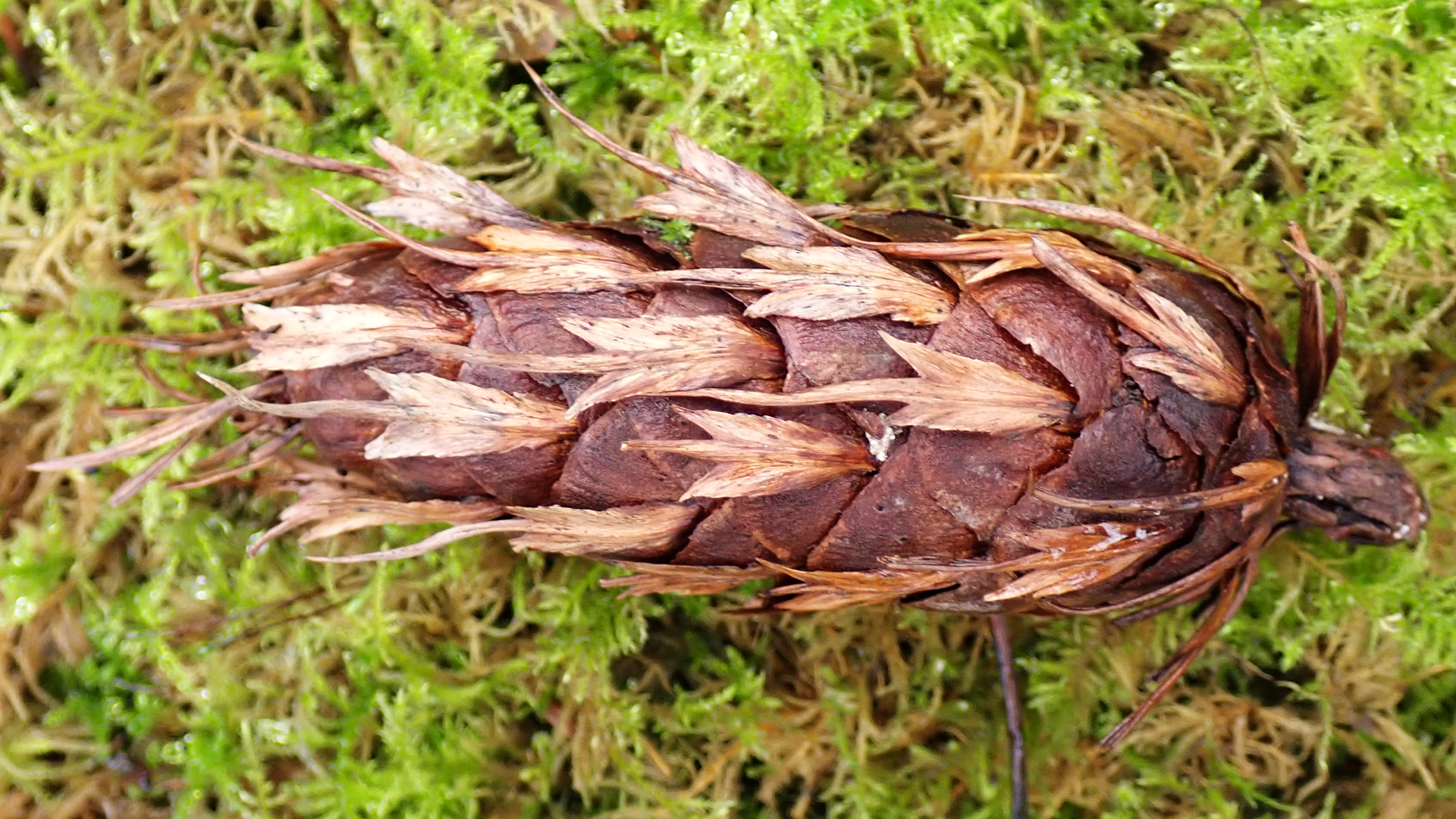
©Raymond Small TQ4791 04/01/2025
A Douglas Fir cone.
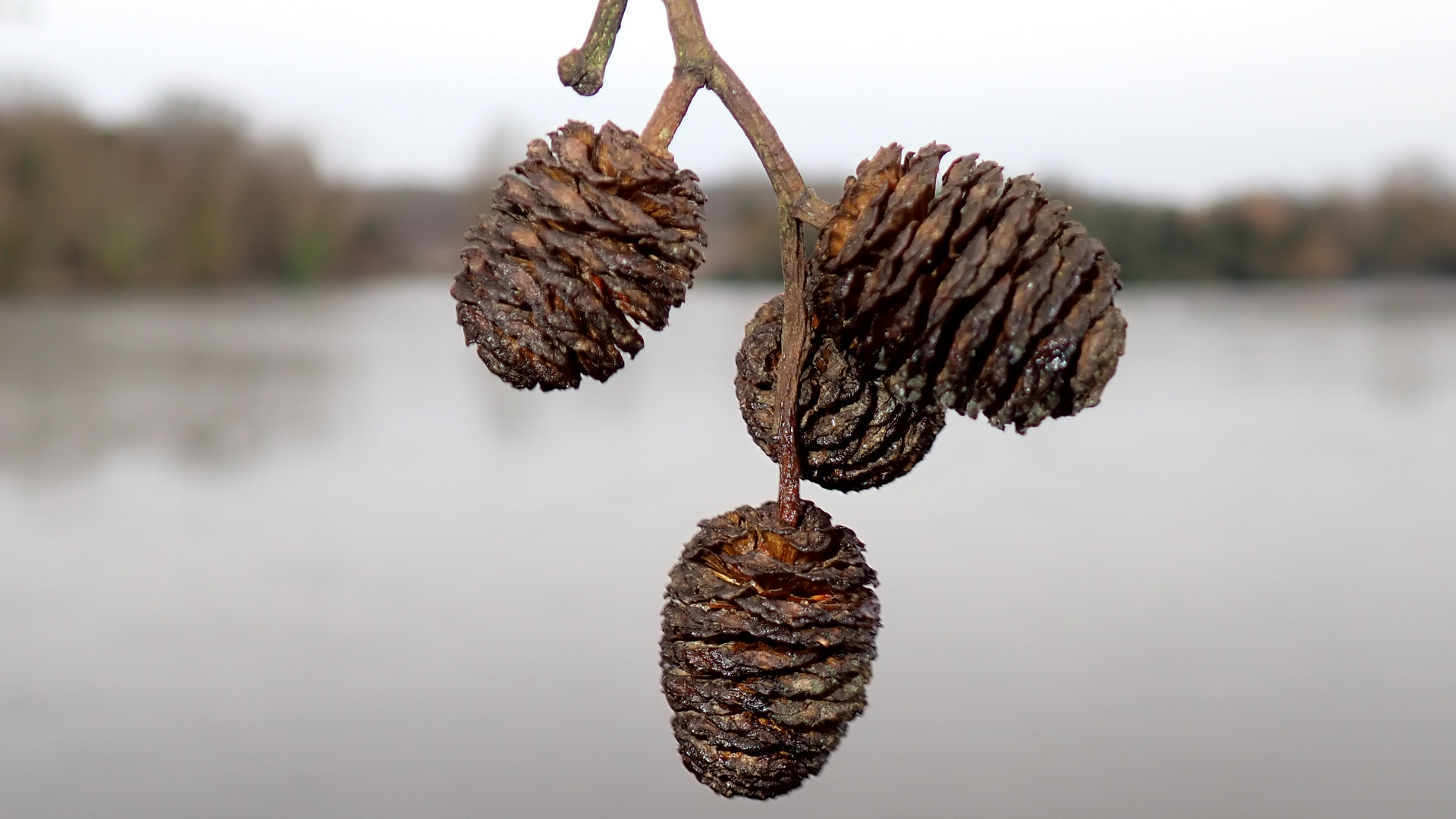
©Raymond Small TQ4892 02/01/2025
Cones are not exclusive to coniferous trees. Grey Alder and Common Alder also bear cones. Alder trees are the only British native deciduous trees to have cones.
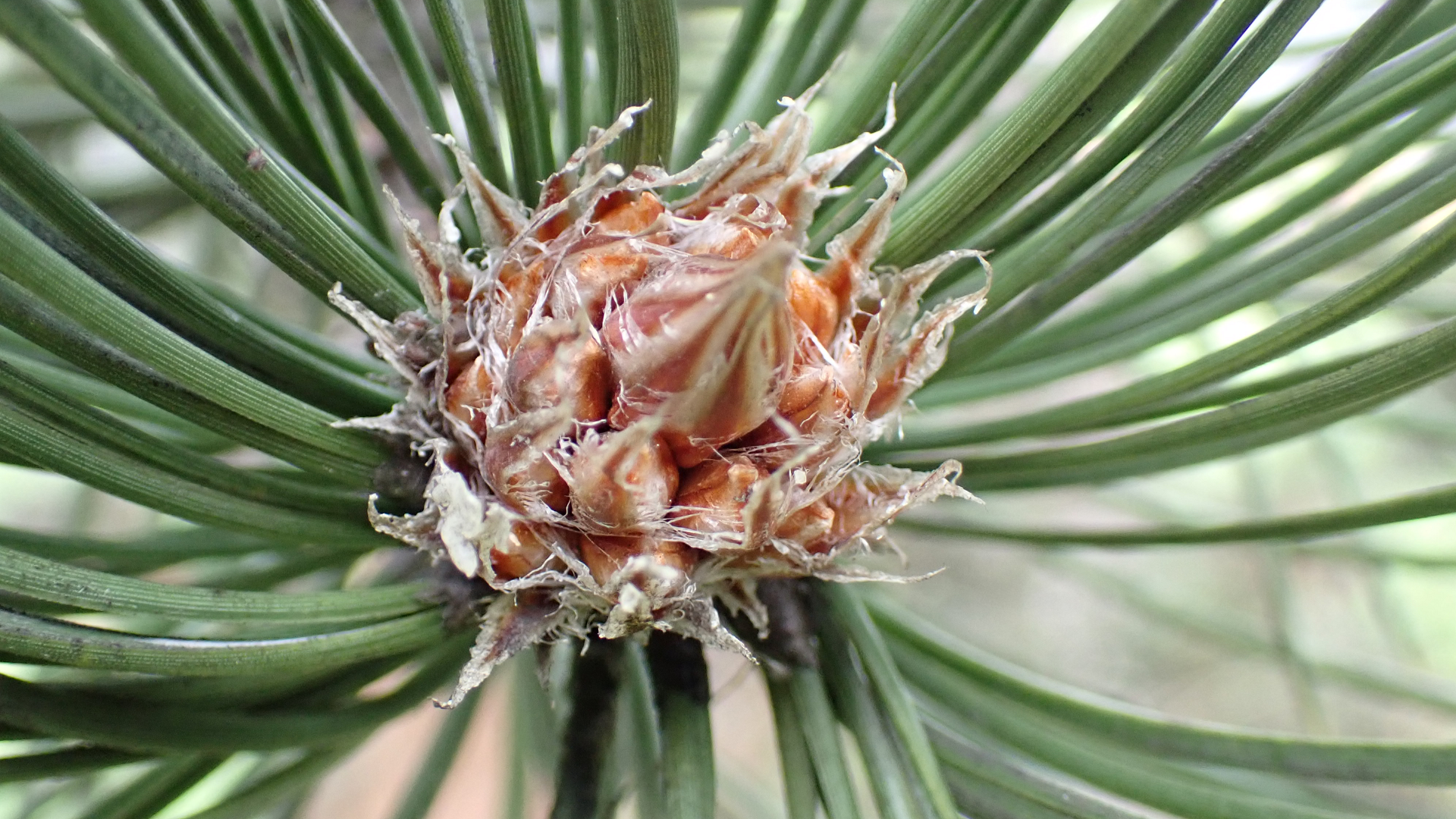
©Raymond Small TQ4792 04/01/2025
There are several pine trees in the centre of the A1112 dual carriageway. During January tiny cones could be found on the branch tips.
BOARDWALK
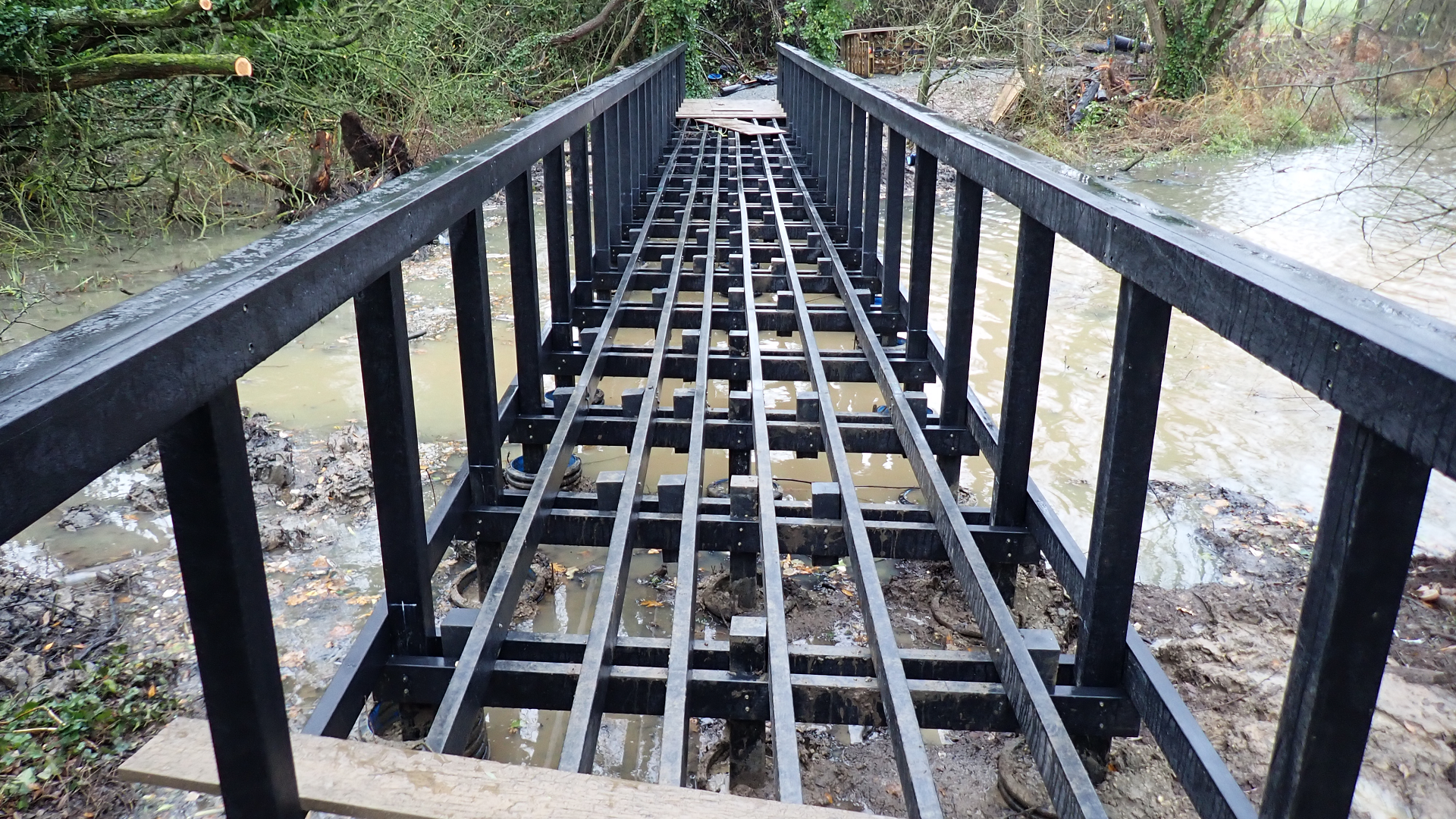
©Raymond Small TQ4792 07/12/2024
A boardwalk is being built at the back of Hainault Lake in the area once known as the Swan Sanctuary, with new paths installed to provide access. No official date has been given for completion.
WETLAND
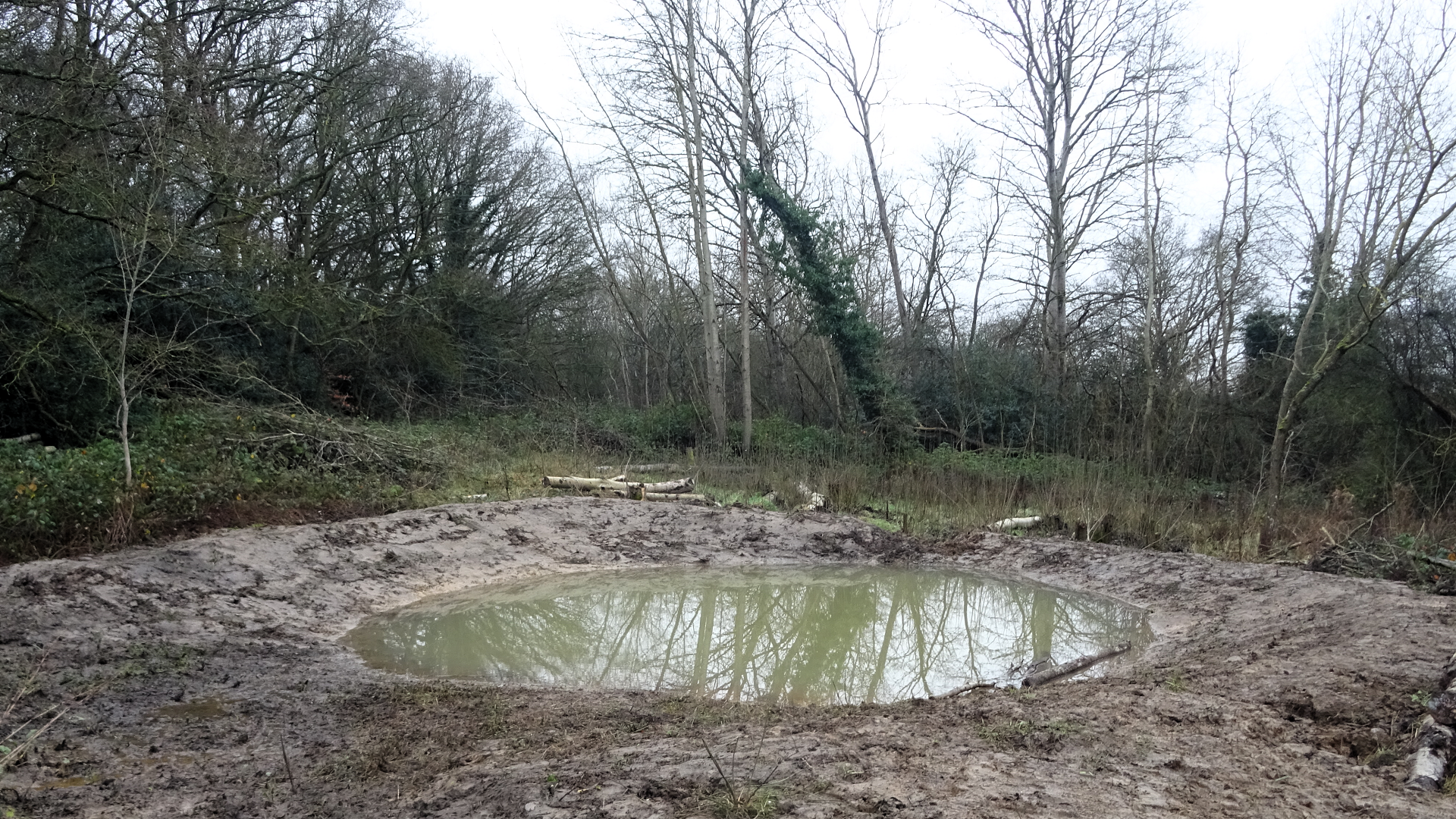
©Raymond Small TQ4793 28/12/2024
An area near Alice's Hedge has been cleared of Silver Birch trees to make a wetland area, one of several projects being carried out by the Conservation Team and volunteers. Work has also included planting trees in the scrub area on Hog Hill, and cutting back the willow hedgerow in Ted's Field next to the lake.
SKELETON
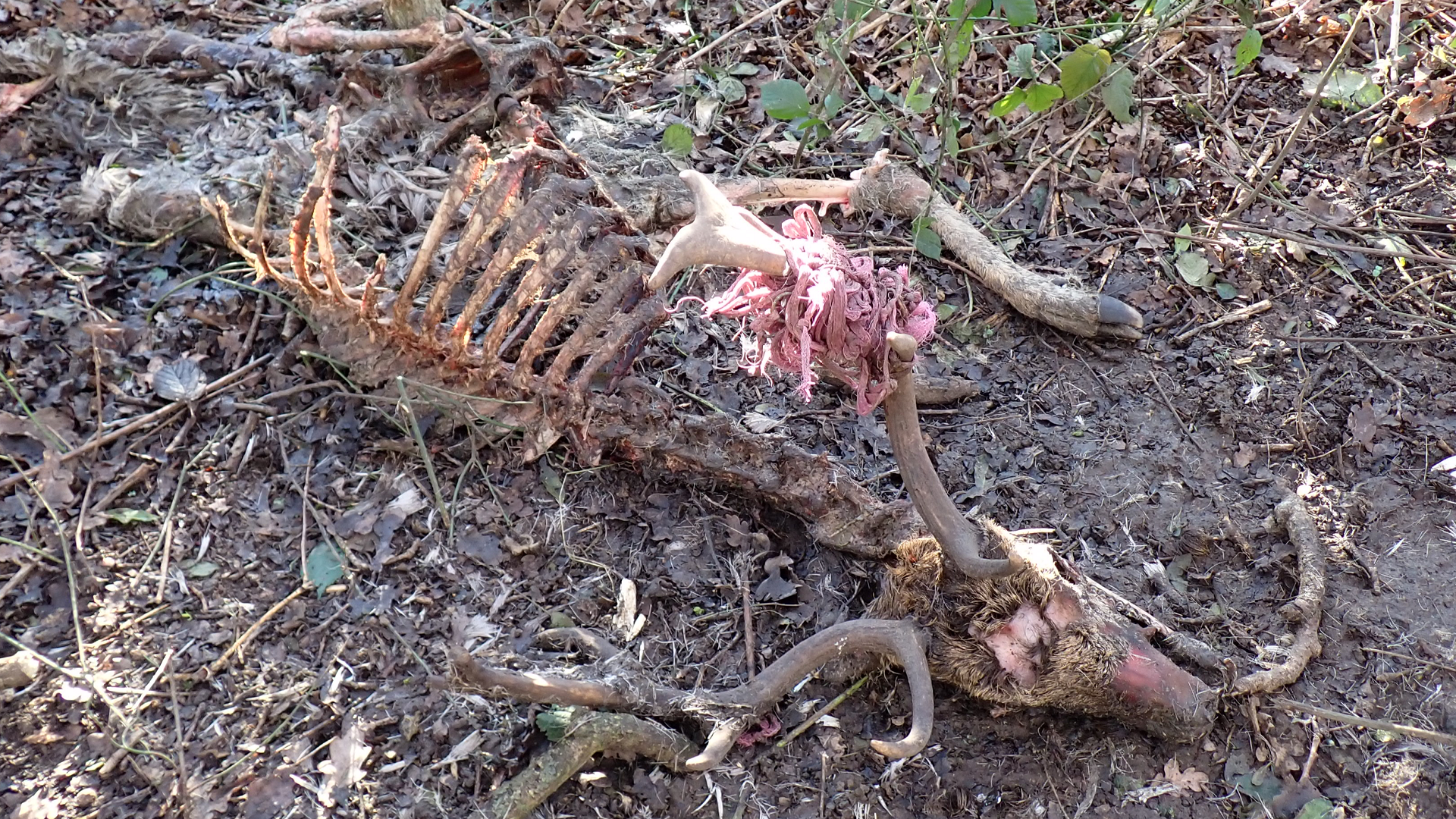
©Raymond Small TQ4793 03/01/2025
A near-complete skeleton of a Fallow Deer was found in the forest near Lambourne End. It appeared to have pinkish rope wrapped around an antler. Sometimes ropes are seen tied to branches that have been used as children's swings. We wondered if this poor animal had been caught up by such a rope in the past. The upper eye socket was empty, possibly pecked away by birds. The eyeball next to the ground was still in place.
A FROSTY START TO 2025
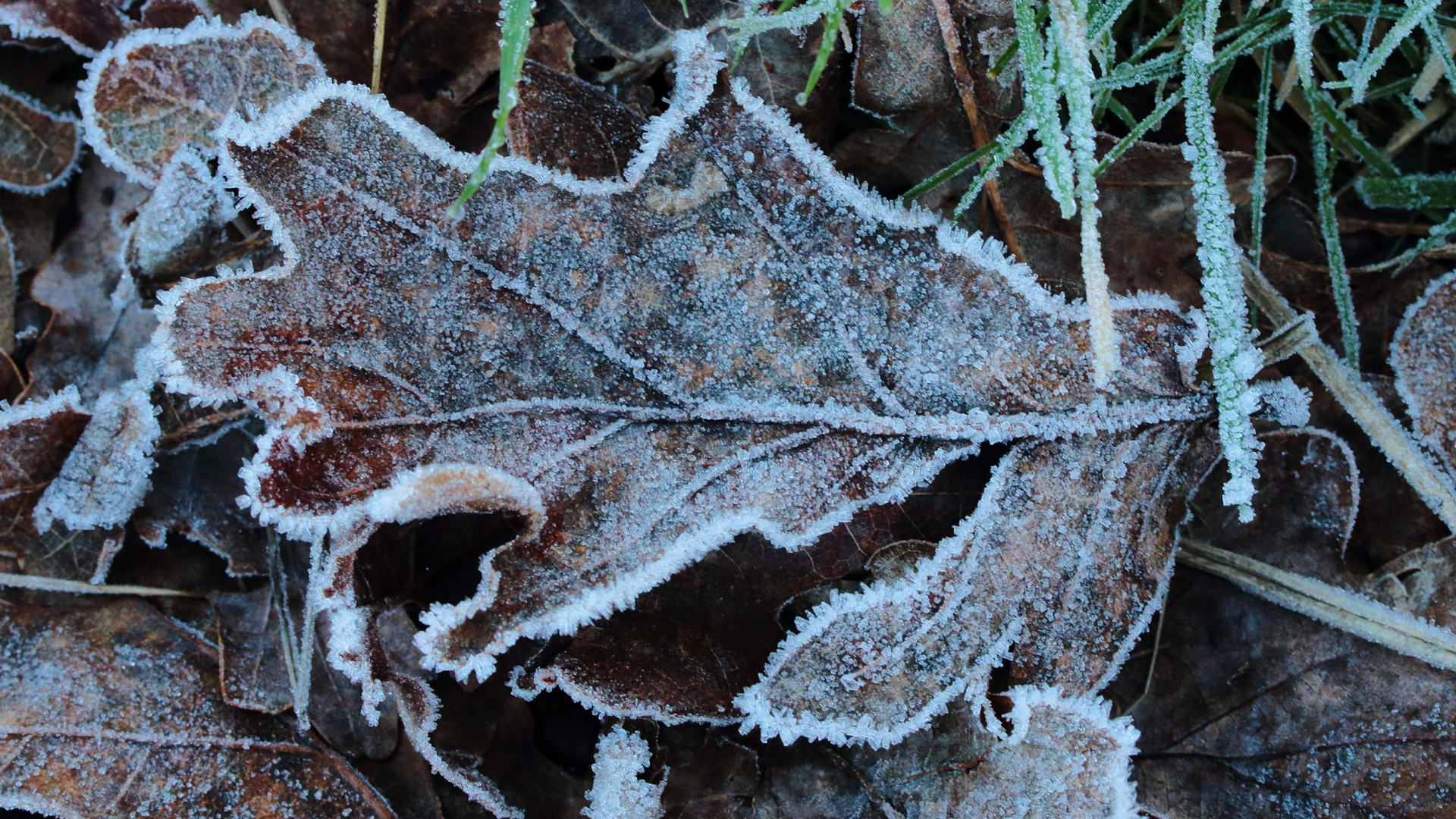
©Mike Rumble TQ4793 03/01/2025
During winter if the night sky is clear with light winds, sufficient moisture is in the air, and the temperature falls between 0 °C and 4 °C, there is a strong possibility of frost forming on the ground and outside surfaces in the morning. This type of frost is known as 'hoar frost'.
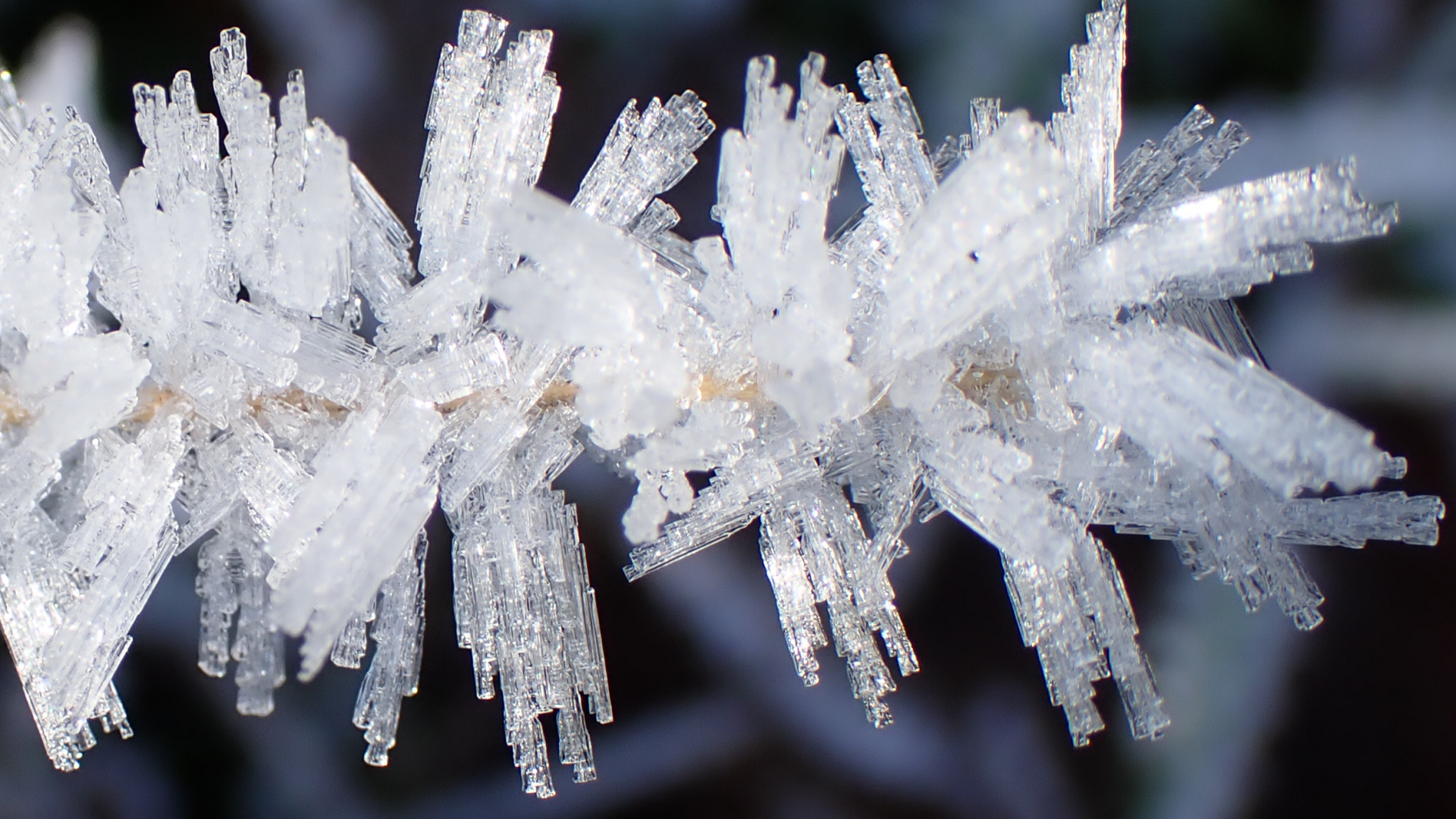
©Raymond Small TQ4792 11/01/2025
Frost crystals grow from water vapour in the air. They are formed by direct condensation of water vapour turning to ice at temperatures below freezing; going from a gas state to a solid state with no melting in between. Snow crystals form on suspended dust particles high in the clouds, unlike frost crystals that develop on surfaces near the ground. When water freezes it forms a hexagonal crystal lattice caused by bipolar molecules being attracted to each other.
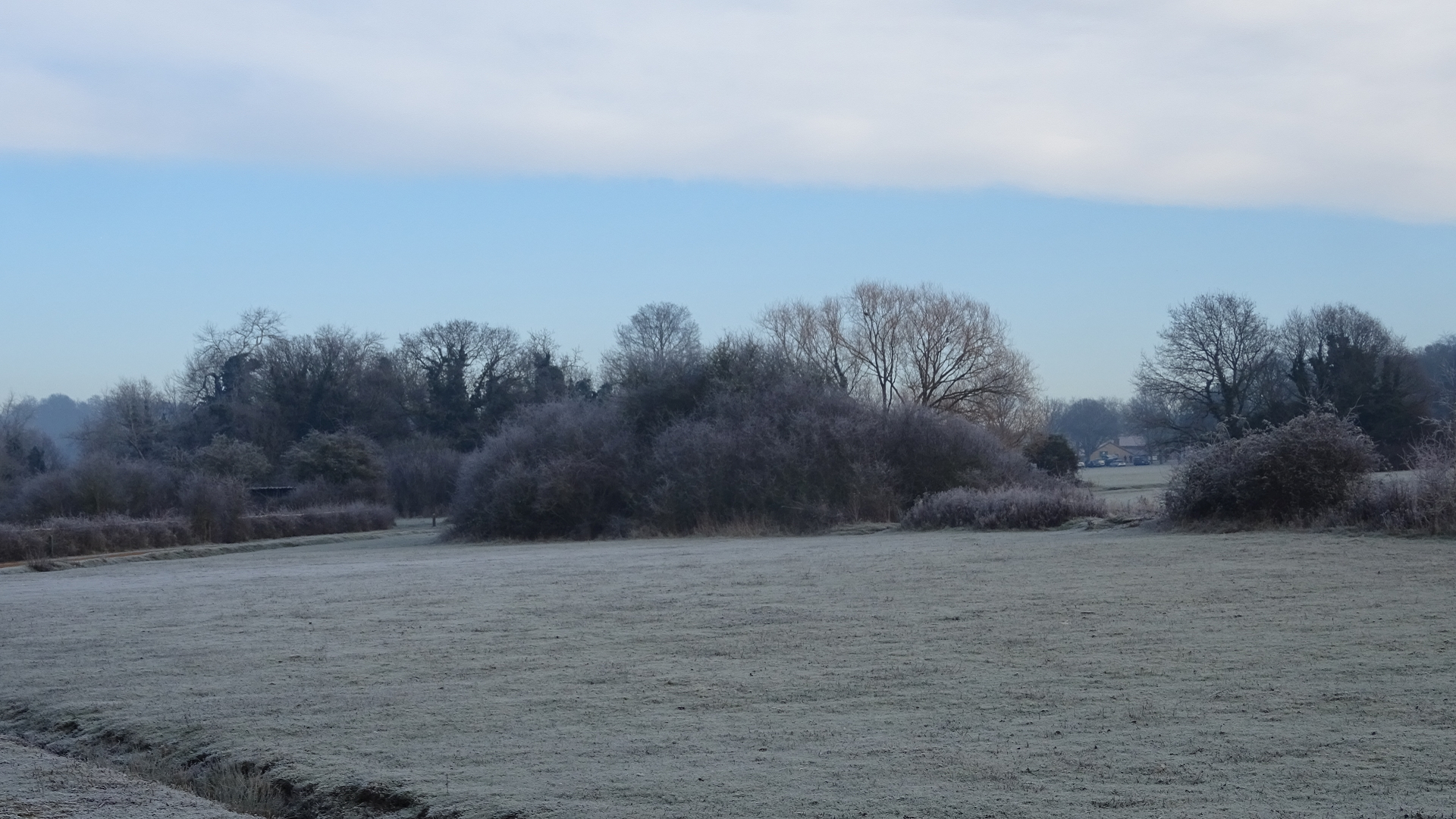
©Raymond Small TQ4792 10/01/2025
Frost is not frozen dew. If the temperature of an object on which the water condenses is above the freezing point of water, the condensation is observed as dew. However, if the temperature of an object is below freezing point, the water vapour develops ice crystals and the condensation is perceived as frost.
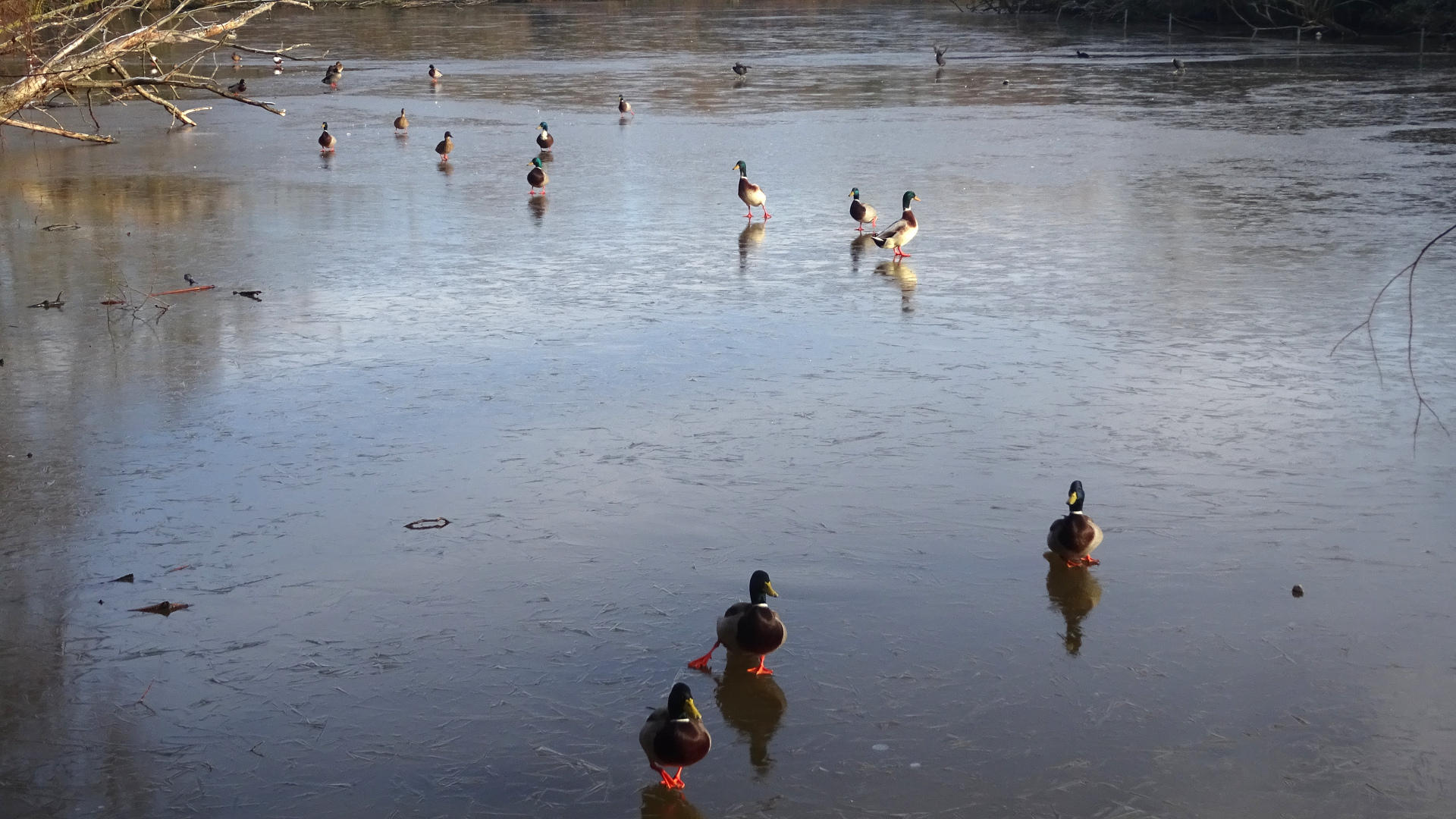
©Raymond Small TQ4792 10/01/2025
It is not easy for ducks to waddle on a frozen lake and they often slip and slide. In winter food can be difficult to find and they will usually appreciate a visitor providing bird seed or duck pellets to help them through the leaner times.
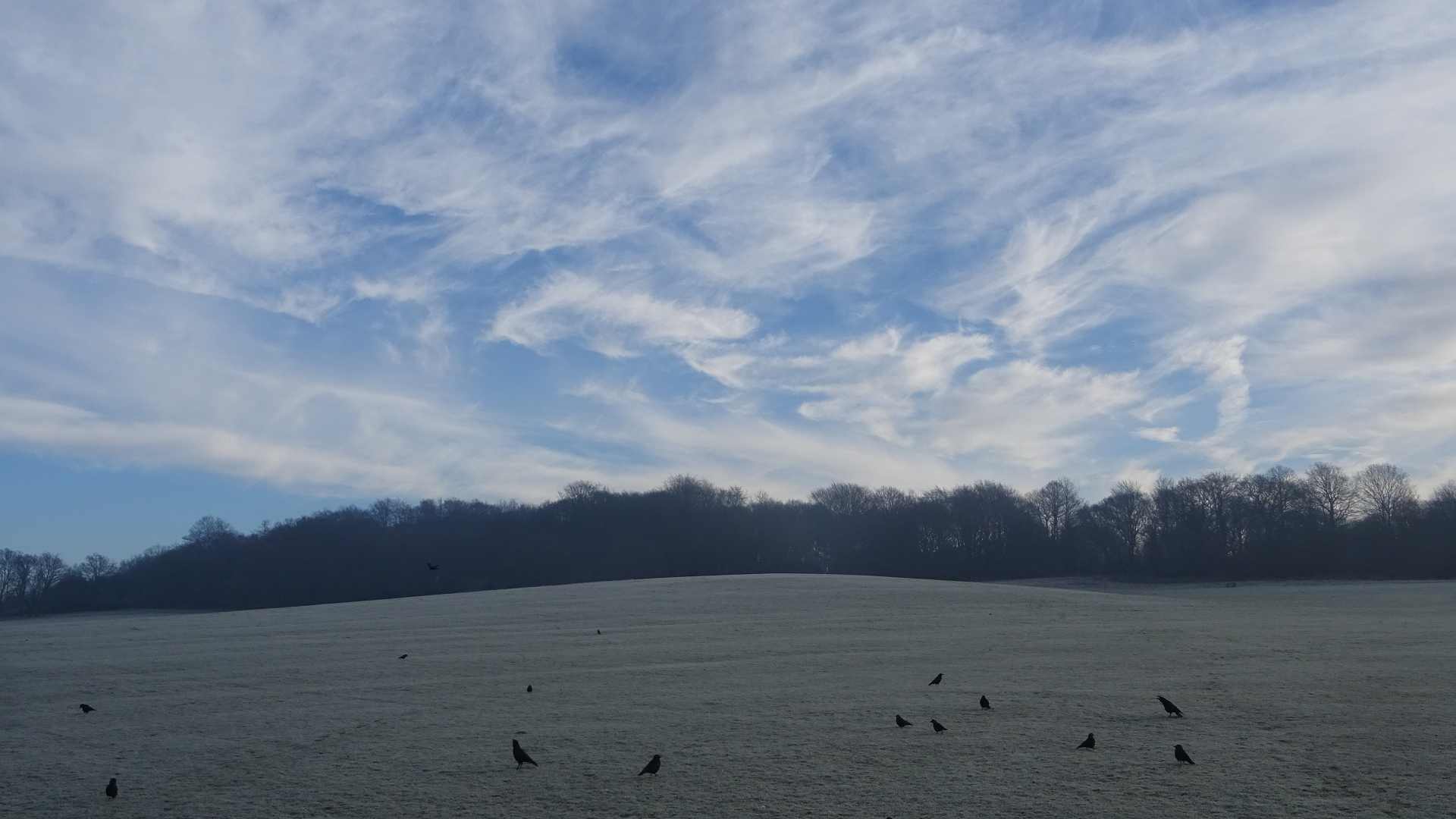
©Raymond Small TQ4792 10/01/2025
Frost-laden ground on Hog Hill with wispy, feathery, clouds overhead. Cirrus clouds are made entirely of ice crystals and are often the first sign of an approaching warm front.

©Raymond Small TQ4792 12/01/2025
Fog occurred several times during January. Fog is a cloud that has formed near the ground caused when water vapour condenses and molecules combine to make tiny water droplets that hang in the air. This normally happens after rain when there is lots of moisture in the air. When air cools it can't hold as much water vapour causing it to condense into cloud droplets.
CORRESPONDENCE
(Recent emails)
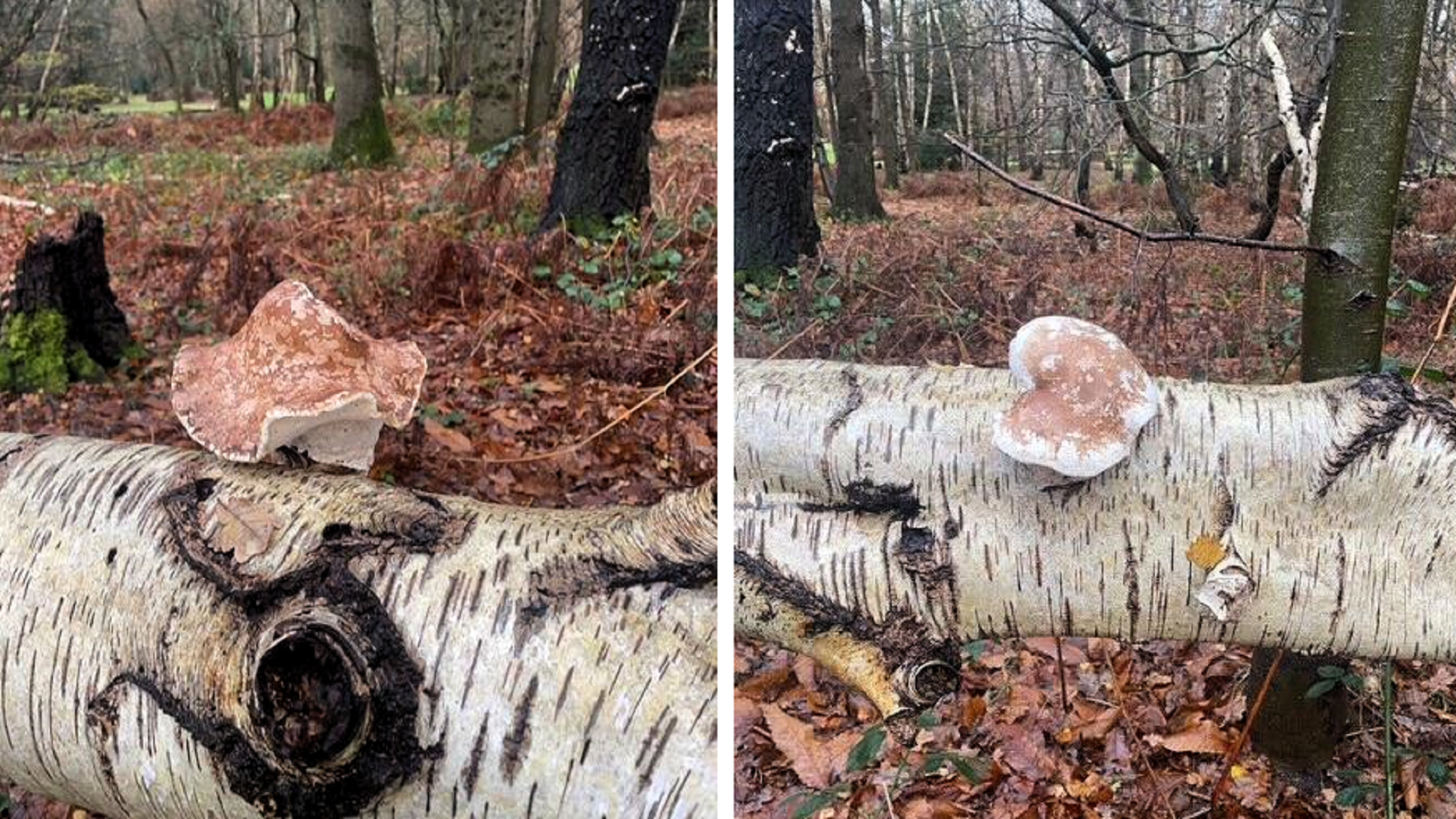
Linda Ljubojev photographed these Birch polypores in Hainault Forest during December. This is a common fungus often found on Silver Birch trees throughout the year.
Thank you for sharing.
Thank you to everyone that has contributed this month.


